*NURSING > EXAM > Test Bank for Porth's Essentials of Pathophysiology 5th Edition by Tommie L Norris| Guide A+ (All)
Test Bank for Porth's Essentials of Pathophysiology 5th Edition by Tommie L Norris| Guide A+
Document Content and Description Below
Test Bank for Porth's Essentials of Pathophysiology 5th Edition by Tommie L Norris Test Bank for Porth's Essentials of Pathophysiology 5th edition by Tommie L Norris 1. Chapter 1 Although the basic st... ructure of the cell plasma membrane is formed by a lipid bilayer, most of the specific membrane functions are carried out by: A) Bound and transmembrane proteins B) Complex, long carbohydrate chains C) Surface antigens and hormone receptors D) A gating system of selective ion channels Feedback: The functions of plasma membrane depend on the presence of proteins that are bound in the lipid bilayer and some that have the ability to pass freely into and out of the cell. Carbohydrate chains form a cell coat that surrounds the membrane and that contain surface antigens and surface hormone receptors. Some ion channels are gated and open only when the membrane potential changes significantly. 2. Which describes the function of the nucleus? A) It is basically the site of protein synthesis in the body. B) It contains the genetic code for the individual. C) It is the transformer of cellular energy. D) It initiates the process of aerobic metabolism. Feedback: The nucleus contains DNA, which contains the genetic code that contains the information that controls cells. Ribosomes synthesize protein. Mitochondria transform organic compounds into cellular energy. Mitochondria require oxygen for aerobic metabolism, using hydrogen and carbon combined with oxygen molecules to form carbon dioxide and water as energy is released. 3. Which of the following aspects of the function of the nucleus is performed by ribosomal RNA (rRNA)? A) Copying and carrying DNA instructions for protein synthesis B) Carrying amino acids to the site of protein synthesis C) Providing the site where protein synthesis occurs D) Regulating and controlling protein synthesis Feedback: There are three types of ribonucleic acid (messenger RNA, ribosomal RNA, and transfer RNA) that move to the cytoplasm and carry out the actual synthesis of proteins. Messenger RNA (mRNA) copies and carries the DNA instructions for protein synthesis to the cytoplasm; ribosomal RNA (rRNA) is the site of protein synthesis; and transfer RNA (tRNA) transports amino acids to the site of protein synthesis for incorporation into the protein being synthesized. 4. Which accurately explains the functions of the organelles lysosomes? They: A) Are sacs filled with enzymes that breakdown and remove foreign substances and worn-out cell parts B) Function in association with the endoplasmic reticulum to modify protein end products and package them into secretory granules or vesicles C) Are small particles of nucleoproteins that are involved in the synthesis of proteins that remain in the cell as cytoplasmic structural or functional elements D) Are a dynamic system of interconnected membranous tubes that functions as a tubular communication system for transporting various substances from one part of the cell to another Feedback: Lysosomes are sacs that are filled with hydrolytic enzymes that aid in the processing and removal of unwanted substances within the cytoplasm. The Golgi apparatus functions in association with the endoplasmic reticulum to modify and package substances in preparation for secretion, whereas ribosomes are small particles of nucleoproteins that are involved in the synthesis of proteins. The ER is a tubular communication system for transporting various substances from one part of the cell to another. 5. Impairment in the function of peroxisomes would result in: A) Inadequate sites for protein synthesis B) An inability to transport cellular products across the cell membrane C) Insufficient energy production within a cell D) Accumulation of free radicals in the cytoplasm Feedback: Peroxisomes function in the control of free radicals; unless degraded, these highly unstable chemical compounds damage other cytoplasmic molecules. Peroxisomes do not directly contribute to energy production, protein synthesis, or transport of cellular secretions. 6. Although energy is not made in mitochondria, they are known as the “power plants” of the cell because they: A) Contain RNA for protein synthesis B) Utilize glycolysis for oxidative energy C) Extract energy from organic compounds D) Store calcium bonds for muscle contractions Feedback: Mitochondria contain the enzymes needed for transforming organic compounds into energy that is easily accessible to the cell. Mitochondria contain their own DNA. Glycolysis is anaerobic metabolism and unrelated to oxidative energy. Mitochondria store phosphate bonds (such as in ATP) to power cellular functions. 7. Semen analysis indicates that the client's sperm have decreased motility. Which of the following cellular components may be defective within the client's sperm? A) Ribosomes B) Microtubules C) Mitochondria D) Microfilaments Feedback: Abnormalities in the structure and function of microtubules and consequent dysfunction of the flagella may contribute to impaired sperm motility. Ribosomes, microfilaments, and mitochondria do not directly contribute to movement in cells such as cilia and flagella. 8. When explaining the function of glycolysis as it relates to anaerobic metabolism, the faculty will mention which of the following key points? Select all that apply. A) Glycolysis requires the use of oxygen to begin the process. B) Glycolysis occurs in mitochondrion-lacking cells. C) Glycolysis provides the majority of the body's energy needs. D) Pyruvic acid is an end result from a series of reactions that converts glucose. , D Feedback: Glycolysis is the anaerobic process by which energy is liberated from glucose, and it is an important source of energy for cells that lack mitochondria. The process also provides a temporary source of energy for cells that are deprived of an adequate supply of oxygen. Glycolysis involves a sequence of reactions that converts glucose to pyruvic acid, with the concomitant production of ATP from ADP. It accounts for a small minority of the body's energy needs and results in NADH, hydrogen ions, ATP, and pyruvic acid. 9. Aerobic metabolism, also known as oxidative metabolism, provides energy to the body by: A) Removing the phosphate bonds from ATP B) Combining hydrogen and oxygen to form water C) Activating pyruvate stored in the cytoplasm D) Breaking down glucose to form lactic acid Feedback: Aerobic metabolism involves the combination of carbon ions from dietary nutrients, hydrogen ions, and oxygen. The result is carbon dioxide and water as energy is released, which is stored in ATP. Phosphate bonds are added (not removed from) to ADP to form ATP. Pyruvate is formed from glucose in the anaerobic process of glycolysis and is converted to lactic acid during anaerobic metabolism. 10. To effectively relay signals, cell-to-cell communication utilizes a chemical messenger system to: A) Displace surface receptor proteins B) Accumulate within cell gap junctions C) Bind to contractile microfilaments D) Release secretions into extracellular fluid Feedback: Signals are transmitted by releasing chemical secretions into extracellular fluid. Chemical signals move through cell-to-cell junctions to reach other cells and may attach to surface receptor proteins. The cytoplasmic contractile microfilaments are incapable of transmitting communication signals. 11. Which identifies correctly how the G protein–linked receptors are similar? A) Their cytosolic domain has intrinsic enzyme activity. B) Insulin is an example of the second messenger cAMP, which binds to an enzyme-linked receptor. C) These linked receptors are involved in rapid synaptic signaling between cardiac electrical cells. D) They have a ligand-binding extracellular receptor component, which causes changes that activate the G protein on the cytoplasmic side of the cell membrane. Feedback: Although there are differences among the G protein–linked receptors, all share a number of features. They all have a ligand-binding extracellular receptor component, which recognizes a specific ligand or first messenger. Upon ligand binding, they all undergo conformational changes that activate the G protein found on the cytoplasmic side of the cell membrane. Instead of having a cytosolic domain that associates with a G protein, enzyme-linked receptors have cytosolic domain either that has intrinsic enzyme activity or that associates directly with an enzyme. The binding of the hormone to a special transmembrane receptor results in activation of the enzyme adenylyl cyclase at the intracellular portion of the receptor. This enzyme then catalyzes the formation of the second messenger cAMP, which has multiple effects on cell function. Insulin, for example, acts by binding to an enzyme-linked receptor. Ion channel–linked receptors are involved in the rapid synaptic signaling between electrically excitable cells. 12. When working with a client who has end-stage renal disease (ESRD) and is receiving peritoneal dialysis, the concept of diffusion can be explained by which of the following statements? A) “If your potassium level is high, then K+ particles will move from your peritoneal cavity into the dialysis solution, where the concentration of K+ is lower.” B) “You will need to give yourself a potent diuretic so that you can pull the potassium into your blood stream and filter the potassium out in your kidneys.” C) “Your potassium molecules are lipid soluble and will dissolve in the lipid matrix of your cell membranes.” D) “If you can get very warm in a sauna, you will heat up your K+ particles, and the kinetic movement of the particles will increase and pass through the cell membranes faster.” Feedback: Diffusion refers to the passive process by which molecules and other particles in a solution become widely dispersed and reach a uniform concentration because of energy created by their spontaneous kinetic movements. In the process of reaching a uniform concentration, these molecules and particles move “downhill” from an area of higher to an area of lower concentration. Lipid-soluble molecules, such as oxygen, carbon dioxide, alcohol, and fatty acids (not K+), become dissolved in the lipid matrix of the cell membrane and diffuse through the membrane in the same manner that diffusion occurs in water. Diuretics are not very effective if a person has ESRD. The rate of diffusion depends on how many particles are available for diffusion, the kinetic movement of the particles, and the number and size of the openings in the membrane through which the molecules or ions can move. The environmental temperature does not play a role in this. 13. A male client with a diagnosis of type 1 diabetes mellitus is experiencing hyperglycemia because he lacks sufficient insulin to increase the availability of glucose transporters in his cell membranes. Consequently, his cells lack intracellular glucose, and it accumulates in his blood. Which of the following processes would best allow glucose to cross his cell membranes? A) Facilitated diffusion B) Simple diffusion C) Secondary active transport D) Endocytosis Feedback: Transport molecules perform facilitated diffusion, in which one substance carries another substance across a cell membrane. Simple diffusion does not require a transport molecule. Glucose does not cross the cell membrane by secondary active transport or endocytosis. 14. The client asks the health care provider to explain phagocytosis. The provider will respond, “Phagocytosis: A) Is a cotransport system that helps with the absorption of the medication.” B) Is the movement of particles from an area of higher concentration to one of lower concentration.” C) Uses proteins to form an open channel through which the drug can move into the cell.” D) Is a process where microorganisms are engulfed and subsequently degraded or killed.” Feedback: Phagocytosis, which means “cell eating,” involves the engulfment and subsequent killing or degradation of microorganisms and other particulate matter. Certain cells, such as macrophages and neutrophils, are adept at engulfing and disposing of invading organisms, damaged cells, and unneeded extracellular constituents. An example of cotransport occurs in the intestine, where the absorption of glucose and amino acids is coupled with sodium transport. The process of diffusion describes particle movement from an area of higher concentration to an area of lower concentration, resulting in an equal distribution of permeable substances across the cell membrane. Ion channels are integral proteins that span the width of the membrane and are normally composed of several polypeptides or protein subunits that form a gating system. Specific stimuli cause the protein subunits to undergo conformational changes to form an open channel or gate through which the ions can move. 15. Exocytosis allows granular content to be released into extracellular fluid by: A) Engulfing and ingesting fluid and proteins for transport B) Killing, degrading, and dissolving harmful microorganisms C) Removing cellular debris and releasing synthesized substances like hormones D) Destruction of particles by lysosomal enzymes for secretion Feedback: In exocytosis, a secretory granule fuses to the inner cell membrane to form an opening, allowing granule contents to be released. The granule contains cellular debris and synthesized substances such as hormones, which it releases into the extracellular fluid. Phagocytosis and pinocytosis—types of endocytosis—function to engulf, kill, and present particles to lysosomal enzymes for degradation. 16. The process responsible for generating and conducting membrane potentials is: A) Diffusion of current-carrying ions B) Millivoltage of electrical potential C) Polarization of charged particles D) Ion channel neurotransmission Feedback: Membrane potentials rely on the permeability of the cell membrane and the diffusion of electrically charged ions. Charged particles are polarized (positive charge on one side of the membrane and negative charge on the opposite side of the membrane), but membrane potential exists when the charges are unbalanced on the two sides. Ion channel neurotransmitters are involved with opening protein channels for purposes of cell-to-cell communication. 17. Epithelial tissues are classified according to the shape of the cells and the number of layers. Which of the following is a correctly matched description and type of epithelial tissue? A) Simple epithelium: cells in contact with the intercellular matrix; some do not extend to surface. B) Stratified epithelium: single layer of cells; all cells rest on the basement membrane. C) Glandular epithelium: arises from surface epithelia and underlying connective tissue. D) Pseudostratified epithelium: multiple layers of cells; the deepest layer rests on the basement membrane. Feedback: Glandular epithelial tissue is formed by cells to produce fluid and arises from surface epithelium, involving connective tissue. Simple epithelium is a single layer of cells resting on the basement membrane; stratified epithelium has more than one layer, with the deepest layer resting on the basement membrane. Pseudostratified epithelium is in contact with the intercellular matrix and may not extend to the surface. 18. Which body tissue exhibits the highest rate of turnover and renewal? A) The squamous epithelial cells of the skin B) The connective tissue supporting blood vessels C) The skeletal muscle that facilitates movement D) The nervous tissue that constitutes the central nervous system Feedback: Cells making up the epithelial tissues generally exhibit a high rate of turnover, which is related to their location and function. Renewal of connective and muscle tissue takes place at a much slower pace, whereas nervous tissue is incapable of postnatal regeneration. 19. While explaining to a post–surgical knee client about the various forms and function of connective tissue, the nurse gives the example of the client's surgical repair of a torn anterior cruciate ligament (ACL), which is due to: A) A reticular fiber problem that interrupted the framework for capillaries B) A dense regular connective tissue tear that is usually rich in collagen fibers that allows ligaments to join bone to bone C) An irregular, dense connective tissue tear of loose connective tissue that is located in the perichondrium D) Irregular filling of spaces between tissues to facilitate keeping of joints and tendons in their proper place Feedback: Dense regular connective tissues are rich in collagen fibers and form the tendons and aponeuroses that join muscles to bone or other muscles and the ligaments that join bone to bone. Dense irregular connective tissue consists of the same components found in loose connective tissue but exhibits a predominance of collagen fibers and fewer cells. This type of tissue can be found in the fibrous sheaths of cartilage (i.e., perichondrium) and bone (i.e., periosteum). Fibroblasts, the most abundant loose connective tissue cells, synthesize the gel-like substance and collagen, elastin, and reticular fibers. Reticular fibers provide a fibrous framework for capillaries. Adipose tissue helps to fill spaces between tissues and keep organs in place. 20. A student asks the instructor what it means when the book states, skeletal muscles are syncytial or multinucleated? The instructor responds: A) “Each of the skeletal muscle cells has an apical, lateral, and basal surface.” B) “They are closely apposed and are joined by cell-to-cell adhesion molecules.” C) “This means that these muscles exhibit cross-striations formed by alternating segments of thick and thin protein filaments, with muscle cells having a branched appearance.” D) “If a skeletal muscle is injured and a portion dies, the adjacent sections of that same skeletal muscle fiber do not die because they have their own nuclear material.” Feedback: Skeletal muscles are syncytial or multinucleated structures, meaning there are no true cell boundaries within a skeletal muscle fiber. The multinucleated arrangement is important in pathologic states where focal necrosis (death) of a portion of skeletal muscle fibers does not result in necrosis death of the adjacent sections of that same skeletal muscle fiber, because those adjacent sections have their own nuclear material. Cardiac muscle exhibits cross-striations formed by alternating segments of thick and thin protein filaments. In contrast to skeletal muscle, cardiac muscle cells may be branched instead of linear and longitudinal. The other noted qualities are associated with epithelial, not skeletal muscle, cells. 21. With skeletal muscle contraction, what prevent the development of cross-bridges between the actin and myosin? Select all that apply. A) Tropomyosin attaches globular heads to the myosin filament. B) Troponin covers the tropomyosin-binding sites and prevents the formation of cross-bridges. C) ATP actually plays a role in the positioning of the myosin filaments and actin. D) The concentration of calcium around the myofibrils will prevent the cross-bridges from being formed. Ans: A, B Feedback: Associated with each actin filament are the two regulatory proteins: tropomyosin and troponin. Tropomyosin, which lies in grooves of the actin strand, provides the site for attachment of the globular heads of the myosin filament. In the noncontracted state, troponin covers the tropomyosin-binding sites and prevents formation of cross-bridges between the actin and myosin. Energy from ATP is used to break the actin and myosin cross-bridges, stopping the muscle contraction. The binding of calcium to troponin uncovers the tropomyosin-binding sites such that the myosin heads can attach and form cross-bridges. 22. Which of the following statements about how smooth muscle differs from skeletal or cardiac muscle are accurate? Smooth muscle: Select all that apply. A) Has dense bodies attached to actin filaments B) Contains sarcomeres between Z lines and M bands C) Contracts more rapidly than skeletal muscles D) Has one centrally located nucleus , D Feedback: Smooth muscle cells are spindle shaped and smaller than skeletal muscle fibers. Each smooth muscle cell has one centrally positioned nucleus. Smooth muscle contains dense bodies that are attached to the membrane, dispersed in the cell, and attached to actin filaments. Smooth muscle has slow contractions and no cross-striations. Sarcomeres are the functional units of cardiac and skeletal muscle only. The sarcomeres extend between Z lines and M bands. 23. A client with a pathophysiologic condition that affects the desmosomes is most likely to exhibit: A) Impaired contraction of skeletal and smooth muscle B) Weakness of the collagen and elastin fibers in the extracellular space C) Impaired communication between neurons and effector organs D) Separation at the junctions between epithelial cells Feedback: Desmosomes are a type of cell junction common in epithelium. Failure of epithelial desmosomes results in the inappropriate separation of adjacent cells. Desmosomes do not contribute to muscle contraction, communication between neurons and effector organs, or the structure of collagen and elastin. 24. When exercising outside on an extremely warm day, the client can feel his heart pounding very rapidly. Thinking in terms of the ability of the aorta to stretch to accommodate more blood circulating during exercise and the warm environment, this is an example of the function of which fibrous protein? A) Collagen B) Reticular C) Elastin D) Ligaments Feedback: Three types of fibers are found in the extracellular space: collagen, elastin, and reticular fibers. Elastin acts like a rubber band; it can be stretched and then returns to its original form. Elastin fibers are abundant in structures subjected to frequent stretching, such as the aorta and some ligaments. Collagen is the most common protein in the body. It is a tough, nonliving, white fiber that serves as the structural framework for skin, ligaments, tendons, and many other structures. Reticular fibers are extremely thin fibers that create a flexible network in organs subjected to changes in form or volume, such as the spleen, liver, uterus, or intestinal muscle layer. 25. While caring for a client who has just been diagnosed with leukocyte adhesion deficiency (LAD), the client asks why he is always sick with an infection. The nurse responds, “LAD is a rare autosomal recessive disorder that results in recurrent infections because of the lack of transmigration. This me Ans: A) Your body doesn't make enough white blood cells.” B) Your white blood cells are not able to leave the blood vessels and move into the area of infection.” C) I don't really understand this, but it sounds like a good question to ask your physician.” D) Your bone marrow is damaged and can't put out enough white blood cells to fight off your infections.” Feedback: Leukocyte adhesion deficiency (LAD) is a rare autosomal recessive disorder characterized by immunodeficiency, resulting in recurrent infections. A WBC differential will reveal extremely elevated levels of neutrophils (on the order of 6–10 times normal) because they are unable to leave the blood vessels. Certain integrins play an important role in allowing white blood cells to pass through the vessel wall, a process called transmigration. 1. Chapter 2 Which of the following clients would be an example of cellular atrophy? A) A middle-aged female experiencing menopause due to loss of estrogen stimulation B) A postnephrectomy client whose remaining kidney enlarges to compensate for the loss C) A hypertensive, noncompliant client who has developed a progressive increase in left ventricular mass D) A female client with the change in uterine size as a result of pregnancy Feedback: In women, the loss of estrogen stimulation during menopause results in atrophic changes in the reproductive organs. Compensatory hypertrophy is the enlargement of a remaining organ or tissue after a portion has been surgically removed or rendered inactive. For instance, if one kidney is removed, the remaining kidney enlarges to compensate for the loss. In hypertension, for example, the increased workload required to pump blood against an elevated arterial pressure results in a progressive increase in left ventricular muscle mass and need for coronary blood flow. The pregnant uterus undergoes both hypertrophy and hyperplasia as a result of estrogen stimulation. 2. A client has experienced significant decreases in mobility and stamina during a 3-week hospital stay for the treatment of a femoral head fracture. Which of the following phenomena most likely accounts for the client's decrease in muscle function? A) Impaired muscle cell metabolism resulting from metaplasia B) Dysplasia as a consequence of inflammation during bone remodeling C) Disuse atrophy of muscle cells during a prolonged period of immobility D) Ischemic atrophy resulting from vascular changes while on bedrest Feedback: Disuse atrophy frequently occurs as a consequence of prolonged periods of muscle inactivity. Metaplasia and dysplasia are not common consequences of immobility and muscle disuse. Similarly, infrequent muscle use does not typically cause vascular changes that result in ischemic atrophy. 3. The client is found to have liver disease, resulting in the removal of a lobe of his liver. Adaptation to the reduced size of the liver leads to which phenomenon in the remaining liver cells? A) Metaplasia B) Organ atrophy C) Compensatory hyperplasia D) Physiologic hypertrophy Feedback: Compensatory hyperplasia can be stimulated in response to loss of vital tissue that is capable of regeneration, such as liver cells. Metaplasia involves replacement of one existing cell type with another fully differentiated cell type. Organ atrophy is caused by irreversible loss of cells. Physiologic hypertrophy is increased size of existing cells resulting from increased workload. 4. A client presents for a scheduled Papanicolaou (Pap) smear. The clinician who will interpret the smear will examine cell samples for evidence of: A) Changes in cell shape, size, and organization B) The presence of unexpected cell types C) Ischemic changes in cell samples D) Abnormally high numbers of cells in a specified field Feedback: A Pap smear is an example of a diagnostic procedure that tests for the presence of cell dysplasia, that is, deranged cell growth of a specific tissue that results in cells that vary in size, shape, and organization. Unexpected cell types are evidence of metaplasia, whereas ischemic changes are associated with cell hypertrophy. Increases in the number of cells are characterized as hyperplasia. 5. When performing an assessment on a school-aged child, the nurse notes that the mucous membranes along the gum margins have a noticeable blue-colored line. At this point, the nurse should ask the parents about possible: A) Liver problems as an infant B) Congenital heart problems C) Exposure to lead D) Second-hand smoke exposure Feedback: The formation of a blue lead line along the margins of the gum is one of the diagnostic features of lead poisoning. Liver problems are usually displayed as jaundice (yellowing of the skin/sclera). Congenital heart problems may exhibit cyanosis, but this would not be just in the gum margins. Second-hand smoke exposure may cause accumulation in the lungs. 6. An elderly client asks her health care provider if the reason she has developed aortic stenosis is because she drank so much milk as a child growing up on a farm. Which of the following responses is most accurate? A) “Drinking lots of real milk as a child may have contributed to the damage in your valve.” B) “Atherosclerosis is a long process that eventually results in calcification of heart valves.” C) “This calcification of your aortic valve is more than likely due to an undiagnosed thyroid problem.” D) “More than likely, calcium has left your bones and collected on your aortic valve.” Feedback: Dystrophic calcification represents the macroscopic deposition of calcium salts in injured tissue. Dystrophic calcification is commonly seen in atheromatous lesions of advanced atherosclerosis, in areas of injury in the aorta and large blood vessels, and in damaged heart valves. For example, calcification of the aortic valve is a frequent cause of aortic stenosis in the elderly. Drinking milk, undiagnosed thyroid problems, and calcium loss from bone causing osteoporosis do not cause damaged heart valves. 7. Which of the following pathophysiologic processes is most likely to result in metastatic calcification? A) Benign prostatic hyperplasia B) Liver cirrhosis C) Impaired glycogen metabolism D) Hyperparathyroidism Feedback: Metastatic calcification is a result of markedly increased serum calcium levels. Because the parathyroid gland is responsible for the regulation of serum calcium levels, hyperparathyroidism creates a risk for hypercalcemia and consequent metastatic calcification. Benign prostatic hypertrophy, cirrhosis, and impaired glycogen metabolism are not implicated in cases of metastatic calcification. 8. Despite the low levels of radiation used in contemporary radiologic imaging, a radiology technician is aware of the need to minimize her exposure to ionizing radiation. What is the primary rationale for the technician's precautions? Radiation: A) Stimulates pathologic cell hypertrophy and hyperplasia B) Results in the accumulation of endogenous waste products in the cytoplasm C) Interferes with DNA synthesis and mitosis D) Decreases the action potential of rapidly dividing cells Feedback: Radiation has a damaging effect on DNA synthesis and mitosis, a process that is especially harmful to rapidly dividing cells. Radiation does not directly influence the action potential of cells or the accumulation of endogenous waste products. Cell changes such as hypertrophy or hyperplasia may result from radiation exposure, but such changes are secondary to interference with DNA synthesis and mitosis. 9. A mother rushes her 4-year-old child to the emergency department after she found an empty Tylenol (acetaminophen) bottle beside her child. The nurse is trying to explain why it is so important to give the child Ipecac to induce vomiting in order to prevent: A) Renal failure B) Seizures C) Liver failure D) Hemorrhage Feedback: Acetaminophen, a commonly used over-the-counter analgesic drug, is detoxified in the liver, where small amounts of the drug are converted to a highly toxic metabolite. This metabolite is detoxified by a metabolic pathway that uses a substance normally present in the liver. When large amounts of the drug are ingested, this pathway becomes overwhelmed and toxic metabolites accumulate, causing massive liver necrosis. 10. The parents of a 4-year-old girl have sought care because their daughter has admitted to chewing and swallowing imported toy figurines that have been determined to be made of lead. Which of the following blood tests should the care team prioritize? A) White blood cell levels with differential B) Red blood cell levels and morphology C) Urea and creatinine levels D) Liver function panel Feedback: Anemia is a cardinal sign of lead toxicity. Consequently, assessment of the quantity and morphology of RBCs is paramount in cases of suspected lead toxicity. White blood cell and liver studies are not central to the care of this client. Lead is indeed nephrotoxic, and urea and creatinine levels are relevant to assessment, but the priority blood test is assessment of the RBCs. 11. A pregnant client is attending a nutrition class for first-time moms. During the class, the instructor stressed that they should avoid consumption of which food that may cause brain damage from methyl mercury exposure? A) Tuna B) Raw hamburger C) Fresh milk D) Beets Feedback: The main source of methyl mercury exposure is from consumption of long-lived fish, such as tuna and swordfish. Fish concentrate mercury from sediment in the water. Because the developing brain is more susceptible to mercury-induced damage, it is recommended that young children and pregnant and nursing women should avoid consumption of fish known to contain high mercury content. None of the other foods listed pose a threat of mercury toxicity. 12. A client has been diagnosed with a gram-negative bacillus in his blood cultures. The health care providers know these bacteria may produce clinical manifestations such as high temperature, high respiratory rate, and low blood pressure. These manifestations are primarily caused by: A) Disrupting the sodium/potassium ATPase pump B) Interrupting oxidative metabolism processes C) The outer layer of the bacterial membrane acting as an endotoxin D) The bacteria causing a decrease in protein synthesis and function Feedback: Bacteria and viruses can replicate within a cell, thus perpetuating the injuries. Gram-negative bacilli have unique characteristics in the structure of the outer membrane. The outer leaflet of the membrane has a lipid portion that acts as an endotoxin. If this bacillus enters the circulatory system, it causes a toxic reaction, with the sufferer developing a high temperature, high respiration rate, and low blood pressure. Other agents that are injurious to cells are unable to replicate in the cell, but they may disrupt the sodium/potassium pump, interrupt oxidative metabolism, or decrease protein synthesis. 13. Which of the following diseases would be considered to be caused by a lack of a specific vitamin or mineral? A) Anorexia nervosa B) Scurvy C) Sickle cell anemia D) Atherosclerosis Feedback: Dietary deficiencies can occur because of a selective deficiency of a single nutrient. Iron deficiency anemia, scurvy, beriberi, and pellagra are examples of injury caused by a lack of specific vitamins or minerals. Anorexia nervosa, sickle cell anemia, and atherosclerosis are not caused by lack of a vitamin/mineral. 14. Free radicals damage cells by: A) Destroying phospholipids in the cell membrane B) Altering the immune response of the cell C) Disrupting calcium storage in the cell D) Inactivation of enzymes and mitochondria Feedback: Free radicals are highly reactive and can damage cells in several ways. One way is by destroying lipids, which results in a loss of cell membrane integrity. Free radicals modify proteins but do not affect the immune function, calcium storage, or intracellular enzymes of cells. 15. A 70-year-old male client has been admitted to a hospital for the treatment of a recent hemorrhagic stroke that has left him with numerous motor and sensory deficits. These deficits are most likely the result of which of the following mechanisms of cell injury? A) Free radical injury B) Hypoxia and ATP depletion C) Interference with DNA synthesis D) Impaired calcium homeostasis Feedback: Stroke is characterized by impaired cerebral circulation and consequent death of neurons from cellular hypoxia. Free radical injury, abnormal DNA synthesis, and impaired calcium homeostasis are not direct consequences of lack of blood flow to body cells. 16. An elderly client has experienced some hypoxia as a result of chronic respiratory problems. Knowing that oxygen -deprived cells result in an accumulation of lactic acid in the cells, physiologically, the client may experience: A) An increase in fat load B) Altered cell membrane permeability C) Retention of lysosomal enzymes D) Cellular shrinkage and dehydration Feedback: Altered membrane permeability impairs the balance, allowing too much of some and not enough of other substances to flow in and out of the cell. The altered permeability, lack of ATP, and loss of functional surface receptors make it difficult for glucose to enter the cell. Excess fat accumulates because it is unable to move through the damaged membrane. Injury to the lysosomal membranes results in the leakage (not retention) of destructive lysosomal enzymes into the cytoplasm and enzymatic digestion of cell components. 17. Injured cells become very swollen as a result of: A) Increased cell protein synthesis B) Altered cell volume regulation C) Passive entry of potassium into the cell D) Bleb formation in the plasma membrane Feedback: Altered cell volume regulation, caused by the impaired permeability of the cell membrane, leads to sodium retention and substance accumulation within the cell. Sodium attracts water, and the cell swells even more. Protein synthesis is decreased in injured cells. Potassium has difficulty entering the cell and accumulates in the serum, due to loss of the ATPase sodium/potassium pump. Bleb formation occurs in the cell that is already swollen and ready to burst. 18. Ischemia and other toxic injuries increase the accumulation of intracellular calcium as a result of: A) Release of stored calcium from the mitochondria B) Improved intracellular volume regulation C) Decreased influx across the cell membrane D) Attraction of calcium to fatty infiltrates Feedback: Disruption of the normal intracellular functions causes the impaired mitochondria to release stored calcium. Cell injury disrupts intracellular volume regulation, allowing excessive influx of substances across the impaired cell membrane. Fatty infiltrate is an ominous sign of cell damage and does not interact with calcium. 19. Which of the following processes associated with cellular injury is most likely to be reversible? A) Cell damage resulting from accumulation of fat in the cytoplasm B) Cellular changes as a result of ionizing radiation C) Cell damage resulting from accumulation of free radicals D) Apoptosis Feedback: Intracellular accumulation of fat leads to serious cell damage, but this is a potentially reversible effect. Ionizing radiation and damage from free radicals are more likely to be permanent, whereas apoptosis is defined as the permanent removal of injured and aged cells. 20. A client with diabetes has impaired sensation, circulation, and oxygenation of his feet. He steps on a piece of glass, the wound does not heal, and the tissue area becomes necrotic. The necrotic cell death is characterized by: A) Rapid apoptosis B) Cellular breakage C) Shrinkage and collapse D) Chronic inflammation Feedback: Apoptosis is a programmed cell death, unrelated to cell injury, and occurs in a controlled, organized manner. Necrosis is an unorganized death of cells that initiates the acute inflammatory response with intracellular swelling and resulting cellular breakage (rupture). 21. A client has been diagnosed with gram-negative pneumonia of the lower lobe. Knowing that gram-negative bacteria have a lipopolysaccharide endotoxin on their outer cell membrane, the health care provider should be assessing the client for which pathophysiological end result? A) Damage to cellular mitochondria B) Increased ATP levels C) Activation of the p53 protein D) Apoptosis Feedback: The extrinsic pathway of apoptosis involves extracellular signaling proteins that bind to cell surface molecules called death receptors and trigger apoptosis. The end result includes activation of endonucleases that cause fragmentation of DNA and cell death. In addition to TNF and Fas ligand, primary signaling molecules known to activate the extrinsic pathway include TNF-related apoptosis-inducing ligand (TRAIL); the cytokine interleukin-1 (IL-1); and lipopolysaccharide (LPS), the endotoxin found in the outer cell membrane of gram-negative bacteria. DNA damage, activation of the p53 protein, and decreased ATP levels are associated with the intrinsic pathway. 22. A person eating peanuts starts choking and collapses. His airway obstruction is partially cleared, but he remains hypoxic until he reaches the hospital. The health care providers will be assessing this client for which of the following physiological events? Select all that apply. A) Cerebral infarction B) Coagulation necrosis C) Rapid phagocytosis D) Protein p53 deficiency , B Feedback: Tissue infarction is caused by prolonged oxygen deprivation, and the resulting large group of dead cells coagulates in the damaged area. During coagulation necrosis, acidosis develops and denatures the enzymatic and structural proteins of the cell. Phagocytosis occurs rapidly during apoptosis, so it does not elicit an inflammatory response. Protein p53 activation initiates apoptosis. 23. A client with diabetes and severe peripheral vascular disease has developed signs of dry gangrene on the great toe of one foot. The client asks, “How this can happen?” Which of the following pathophysiologic processes should the nurse explain to this client? “More than likely, your gangrene is caused by: A) Inappropriate activation of apoptosis, which means death of your cells.” B) Bacterial invasion into the foot and toe.” C) Impaired arterial blood supply to your toe.” D) Metaplastic cellular changes in your toe.” Feedback: Dry gangrene is often a result of impaired arterial blood supply to the extremities. A bacterial etiology is more common in wet gangrene, whereas neither metaplasia nor activation of apoptosis is implicated in cases of dry gangrene. 24. A group of elderly residents were commenting on how many cell functions decline with age. One resident commented that many of his friends who lived under large electromagnetic towers seemed to experience aging at an accelerated rate in comparison with residents who lived nearby in lakefront housing. This observation is the basis for which theory on aging? A) Theories of genetic influences B) Programmed cell receptor theories C) Insufficient telomerase enzyme theory D) Error theory associated with DNA damage Feedback: Error theory suggests that aging results from DNA mutation or faulty repair. Another group of theories of aging focuses on programmed cell changes with genetic influences that systematically cause cell senescence. Elimination of receptor sites is not part of aging theory. Telomerase enzyme is thought to reduce the shortening of the chromosomes and loss of telomere DNA with each cell replication. 25. Which of the following facts underlies the concept of replicative senescence? A) Genes controlling longevity are present or absent in varying quantities among different individuals. B) Telomeres become progressively shorter in successive generations of a cell. C) The damaging influence of free radicals increases exponentially in later generations of a cell. D) Aging produces mutations in DNA and deficits in DNA repair. Feedback: Replicative senescence implies that cells have limited capacity for reproduction, largely as a result of the shortening of telomeres and consequent chromosomal damage. Genetic theories, the influence of free radicals, and DNA mutation are not central to the concept of replicative senescence. 1. Chapter 3 A client with poor arterial circulation in the lower limbs has developed areas of inflammation and “weeping” clear serous exudate. Since chronic inflammation lasts for a long time, it has been associated with which of the following changes in physiological response? Select all that apply. A) Formation and development of new blood vessels B) The death of one or more cells in the body within a localized area C) Release of a number of potent inflammatory mediators, altering adhesive properties D) Regulation and modulation of the immune response through synthesis and release of inflammatory mediators E) Release of scavenger cells capable of engulfing bacteria through phagocytosis , B Feedback: Chronic inflammation is of a longer duration, lasting for days to years, and is often associated with the proliferation of blood vessels (angiogenesis), tissue necrosis, and fibrosis (scarring). Endothelial cells are also key players in the inflammatory response. They regulate leukocyte extravasation by expression of adhesion molecules and receptor activation and contribute to the regulation and modulation of immune responses through synthesis and release of inflammatory mediators. Activated platelets also release a number of potent inflammatory mediators, thereby increasing vascular permeability and altering the chemotactic, adhesive, and proteolytic properties of the endothelial cells. Neutrophils are scavenger cells capable of engulfing bacteria and other cellular debris through phagocytosis. 2. During a lecture on inflammation, the physiology instructor discusses the major cellular components involved in the inflammation response. The instructor asks, “Which of the following cells arrives early in great numbers?” The student with the correct response is: A) Basophils B) Lymphocytes C) Neutrophils D) Monocytes Feedback: Neutrophils are the primary early arrival cells and are signified by an elevated neutrophil count that includes mature (PMNs) and immature (bands) cell forms. Basophils respond later. Lymphocytes have a slower arrival and stay longer. The half-life of circulating monocytes is about a day, after which they begin to migrate to the site of injury and mature into larger macrophages, which have a longer half-life and greater phagocytic ability than do blood monocytes. 3. A diabetic client has injured his foot while walking barefoot on the lawn. On admission, which of the following assessment findings would be considered a localized cardinal sign of acute inflammation? A) Temperature of 101°F B) Fatigue with listlessness C) Redness and edema at the injured site D) Urine output of less than 500 mL/24 hours (low) Feedback: Localized manifestations include redness, swelling, and heat. Fever and fatigue are systemic manifestations of acute inflammation. Low urine output is not a localized sign but could be a systemic manifestation if the client goes into septic shock. 4. An older adult client has just sheared the skin on her elbow while attempting to boost herself up in bed, an event that has precipitated acute inflammation in the region surrounding the wound. Which of the following events will occur during the vascular stage of the client's inflammation? A) Outpouring of exudate into interstitial spaces B) Chemotaxis C) Accumulation of leukocytes along the epithelium D) Phagocytosis of cellular debris Feedback: The vascular stage of acute inflammation includes the outpouring of exudate into the extravascular spaces. Margination (epithelial accumulation of leukocytes), chemotaxis, and phagocytosis take place during the cellular stage. 5. A client cuts herself with a sharp knife while cooking dinner. The client describes how the wound started bleeding and had a red appearance almost immediately. The nurse knows that in the vascular stage of acute inflammation, the vessels: A) Bleed profusely until the body can compensate and start to send fibrinogen to the wound B) Vasodilate causing the area to become congested causing the red color and warmth C) Constrict as a result of “fight/flight” hormone release resulting in pale-colored skin D) Swell to the point of compromising circulation causing the limb to become cool to touch Feedback: Vasodilation allows more blood and fluid into the area of injury, resulting in congestion, redness, and warmth. Vasodilation is quickly followed by increased permeability of the microvasculature. The loss of fluid results in an increased concentration of blood constituents (red blood cells, leukocytes, platelets, and clotting factors), stagnation of flow, and clotting of blood at the site of injury. This aids in limiting the spread of infectious microorganisms. The loss of plasma proteins increases fluid movement from the vascular compartment into the tissue space and producing the swelling, pain, and impaired function that are the cardinal signs of acute inflammation. 6. A group of teenagers spent an entire day on the beach without using sunscreen. The first night, their skin was reddened and painful to touch. The second day, they awoke to find large fluid-filled blisters over several body areas. The nurse recognizes the development of blisters as which type of inflammatory response? A) Cellular response B) Immediate transient response C) Continuous response D) Delayed response Feedback: The first pattern is an immediate transient response, which occurs with minor injury. It develops rapidly after injury and is usually reversible and of short duration (15 to 30 minutes). The second pattern is an immediate sustained response. The third pattern is a delayed response, in which the increased permeability begins after a delay of 2 to 12 hours, lasts for several hours or even days, and involves venules as well as capillaries. A delayed response often accompanies injuries due to radiation, such as sunburn. The cellular stage of acute inflammation is marked by changes in the endothelial cells lining the vasculature and movement of phagocytic leukocytes into the area of injury or infection. 7. During lecture on wound care, the instructor mentions the final stage of the cellular response of acute inflammation. Of the following statements, which describes what physiologically occurs in the final stage? A) Leukocytes accumulate and begin migration to the site of injury. B) Chemokines direct the trafficking of leukocytes. C) Mediators are transformed into inactive metabolites. D) Neutrophils, monocytes, and macrophages engulf and degrade the bacteria/cellular debris. Feedback: During the final stage of the cellular response, neutrophils, monocytes, and tissue macrophages are activated to engulf and degrade the bacteria and cellular debris in a process called phagocytosis. During the early stages of the inflammatory response, signaling between blood leukocytes and the endothelial cells defines the inflammatory event and ensures arrest of the leukocytes along the endothelium. This process of leukocyte accumulation is called margination. Once leukocytes exit the capillary, they crawl through the tissue guided by a gradient of secreted chemoattractants, such as chemokines, bacterial and cellular debris, and fragments generated from activation of the complement system. Chemokines are small proteins that direct the trafficking of leukocytes during the early stages of inflammation or injury. Once activated and released from the cell, most mediators are short-lived. They may be transformed into inactive metabolites, inactivated by enzymes, or otherwise scavenged or degraded. 8. A client presents to the clinic with a swollen, painful “hang nail” on the index finger. There is a large pustule over the site that needs to be lanced. The health care worker knows that which mediator of inflammation causes this increase in capillary permeability and pain? A) Serotonin B) Histamine C) Bradykinin D) Nitric oxide Feedback: Bradykinin causes increased capillary permeability and pain. Serotonin and histamine are released by the mast cell degranulation. Histamine causes arteriole dilation and increased permeability of venules. Serotonin has actions similar to those of histamine. Nitric oxide relaxes smooth muscle and reduces platelet aggregation and adhesion. 9. A client has an abscess in the mouth with a profuse amount of thick creamy white exudate. The nurse knows that this wound with necrotic cells is classified as: A) Serous B) Fibrinous C) Suppurative D) Membranous Ans: D Feedback: Membranous or pseudomembranous exudates develop on mucous membrane surfaces. It is an acute inflammatory response to a powerful necrotizing toxin with formation on a mucosal surface, of a false membrane composed of precipitated fibrin, necrotic epithelium, and inflammatory white cells. Serous exudate is a watery fluid. Fibrinous exudates contain fibrinogen and form a thick sticky meshwork. Suppurative exudate contains pus. 10. In contrast to acute inflammation, chronic inflammation is characterized by which of the following phenomena? A) Profuse fibrinous exudation B) A “shift to the left” of granulocytes C) Metabolic and respiratory alkalosis D) Lymphocytosis and activated macrophages Feedback: Chronic inflammation requires lymphocytes and macrophages to remain in large numbers for the high use of immune cells. Chronic inflammation is associated with fibroblast proliferation instead of exudations. A “shift to the left” is characteristic of acute inflammation with a high neutrophil count. Inflammation, with continued cell injury, is a source of metabolic and respiratory (if the lungs are the site of inflammation) acidosis. 11. Which of the following individuals most likely has the highest risk of experiencing chronic inflammation? A client who: A) Has recently been diagnosed with type 2 diabetes B) Is a carrier of an antibiotic-resistant organism C) Is taking oral antibiotics for an upper respiratory infection D) Is morbidly obese and who has a sedentary lifestyle Feedback: Obesity has been linked to chronic inflammation. Acute infections, diabetes, and being a carrier of a microorganism are not circumstances that are noted to cause chronic inflammation. 12. The nurse notes the client has developed a systemic response of inflammation based on assessment findings. Which of the following clinical manifestations support this diagnosis? Select all that apply. A) Temperature of 100.9°F, lethargy B) Pulse rate 130 beats/minute (high) C) Generalized achiness D) Low urine output E) Pounding, throbbing headache , B, C Feedback: Manifestations of the acute-phase response include fever, increased heart rate, anorexia, somnolence, and malaise. Low urine output and throbbing headache are not an acute response. 13. Which of the following lab results confirm the client has developed an acute-phase inflammatory response? Select all that apply. A) Erythrocyte sedimentation rate (ESR) 175 mm/h (high). B) Red blood cell count (RBC) 3.11 cells/L (low). C) Leukocytes (WBC) 18.7 cells/L (high). D) C-reactive protein (CRP) 10.0 mg/L (high). E) Fibrinogen level 1.5 g/L (normal). , C, D Feedback: During the acute-phase response, the liver dramatically increases the synthesis of acute-phase proteins such as fibrinogen, C-reactive protein (CRP), and serum amyloid A protein (SAA) that serve several different defense functions. The synthesis of these proteins is stimulated by cytokines, especially TNF-, IL-1 (for SAA), and IL-6 (for fibrinogen and CRP). The accelerated erythrocyte sedimentation rate (ESR) that occurs in disease conditions is characterized by the systemic inflammatory response. Leukocytosis, or the increase in white blood cells, is a frequent sign of an inflammatory response, especially those caused by bacterial infection. In acute inflammatory conditions, the white blood cell count commonly increases from a normal value of 4000 to 10,000 cells/L. 14. A client asks why his temperature is always below 98.6°F. The nurse responds: A) Some people maintain a core body temperature of 41°C and that is normal for them. B) Normal core temperature varies between individuals within the range of 97.0°F to 99.5°F. C) A person's highest point of core temperature is usually first thing in the morning. D) The best way to bring your body temperature up to normal is to live in a warmer climate. Feedback: Core temperature is normally maintained within a range of 36.0°C to 37.5°C (97.0°F to 99.5°F). A core temperature greater than 41°C (105.8°F) or less than 34°C (93.2°F) usually indicates that the body's thermoregulatory ability is impaired. Body heat is generated in the tissues of the body, transferred to the skin surface by the blood, and then released into the environment surrounding the body. The thermoregulatory center regulates the temperature of the deep body tissues, or “core” of the body, rather than the surface temperature. Internal core temperatures reach their highest point in late afternoon and evening and their lowest point in the early morning hours. 15. A postsurgical client who is recovering in the postanesthetic recovery unit states that she is “freezing cold.” Which of the following measures is likely to be initiated in the client's hypothalamus in an effort to reduce heat loss? A) Opening of arteriovenous (AV) shunts B) Reduced exhalation of warmed air C) Contraction of pilomotor muscles D) Decreased urine production Feedback: Contraction of the pilomotor muscles reduces the surface area available for heat loss. Opening of the AV shunts exacerbates heat loss. The body does not normally adjust urine production or decrease exhalation in response to heat loss. 16. An elderly client is dressed only in a hospital gown and complains of a draft in her room. Consequently, she has requested a warm blanket while she sits in her wheelchair. Which of the following mechanisms of heat loss is most likely the primary cause of her request? A) Evaporation and conduction B) Radiation and convection C) Conduction and convection D) Convection and evaporation Feedback: Approximately 60% of heat loss typically occurs through radiation to the surrounding air. Convection is heat loss related to air currents, such as those in a drafty room. 17. Which of the following clients have a pathophysiologic process capable of causing fever by inducing the production of pyrogens? Select all that apply. A) A farmer who cut his arm while sharpening his tools coming to clinic because of acute inflammation signs like fever and redness B) A middle-aged obese client complaining of “knees hurting and swelling by the end of the day” C) An older adult recuperating following a myocardial infarction D) A newly diagnosed Hodgkin lymphoma client E) A 30-year-old end-stage renal failure client receiving hemodialysis three times per week , C, D Feedback: Inflammation, myocardial infarction, and malignancies are all processes that result in the production and release of pyrogens. Obesity and renal failure are not noted to directly result in pyrogen production and consequent fever. 18. Exogenous pyrogens (interleukin-1) and the presence of bacteria in the blood lead to the release of endogenous pyrogens that: A) Stabilize thermal control in the brain B) Produce leukocytosis and shivering C) Block viral replication in cells D) Inhibit prostaglandin release Feedback: Exogenous pyrogens induce host cells, such as blood leukocytes and tissue macrophages, to produce fever-producing mediators called endogenous pyrogens (e.g., IL-1). For example, the breakdown products of phagocytosed bacteria that are present in the blood lead to the release of endogenous pyrogens. The endogenous pyrogens are thought to increase the set point of the hypothalamic thermoregulatory center through the action of prostaglandin E2 (PGE2). In response to the sudden increase in set point, the hypothalamus initiates heat production behaviors (shivering and vasoconstriction) that increase the core body temperature to the new set point, and fever is established. Pyrogens are not capable of blocking viral replication or prostaglandin release. 19. Which of the following clients is most likely to be susceptible to developing a neurogenic fever? A client who has: A) Stage II Alzheimer disease B) Sustained a head injury in a bicycle crash C) Become delirious after the administration of a benzodiazepine D) Begun taking a selective serotonin reuptake inhibitor (SSRI) for the treatment of depression Feedback: Neurogenic fever is the result of damage to the hypothalamus caused by central nervous system trauma, intracerebral bleeding, or an increase in intracranial pressure. All these problems may be precipitated by a head injury. Alzheimer disease and drug administration are not typical causes of a neurogenic fever. 20. A client has sought care because of recent malaise and high fever. Upon assessment, the client states that his current fever began 2 days earlier, although he states that for the last 2 weeks he is in a cycle of high fever for a couple of days followed by a day or two of normal temperature. Which of the following fever patterns is this client experiencing? A) Recurrent fever B) Remittent fever C) Sustained fever D) Intermittent fever Feedback: A recurrent or relapsing fever pattern is one in which there is one or more episodes of fever, each lasting as long as several days, with one or more days of normal temperature between episodes. An intermittent fever is one in which temperature returns to normal at least once every 24 hours, whereas sustained and remittent fevers do not involve a return to normal temperature range. 21. Which assessment findings of a client with an elevated temperature would be considered a “normal” finding? Select all that apply. A) Flushed skin B) White, cheesy patches on oral mucous membranes C) Pain when moving joints to sit up in bed D) Unusual fatigue and drowsiness E) Complaining of “spots before the eyes” , C, D Feedback: Common manifestations of fever are anorexia, myalgia, arthralgia, and fatigue. These discomforts are worse when the temperature rises rapidly or exceeds 39.5°C (103.1°F). Respiration is increased, and the heart rate usually is elevated. Dehydration occurs because of sweating and the increased vapor losses caused by the rapid respiratory rate. White, cheesy patches in the mouth are usually associated with a fungal infection. Spots before one's eyes are unrelated to fever. 22. While sponging a client who has a high temperature, the nurse observes the client begins to shiver. At this point, the priority nursing intervention would be to: A) Administer an extra dose of aspirin B) Stop sponging the client and retake a set of vital signs C) Increase the room temperature by turning off the air conditioner and continue sponging the client with warmer water D) Place a heated electric blanket on the client's bed Feedback: Modification of the environment ensures that the environmental temperature facilitates heat transfer away from the body. Sponge baths with cool water or an alcohol solution can be used to increase evaporative heat losses. More profound cooling can be accomplished through the use of a cooling blanket or mattress, which facilitates the conduction of heat from the body into the coolant solution that circulates through the mattress. Care must be taken so that cooling methods do not produce vasoconstriction and shivering that decrease heat loss and increase heat production. 23. A client arrived in the emergency department following 2 days of general malaise. The temperature is 103.8°F. The nurse administers the prescribed aspirin, an antipyretic. Which of the following statements relates to the rationale for this action? A) Temperatures in excess of 37.5°C (99.5° F) can result in seizure activity. B) Lower temperatures inhibit the protein synthesis of bacteria. C) These medications protect vulnerable organs, such as the brain, from extreme temperature elevation. D) Most common antipyretics have been shown to have little effect on core temperature. Feedback: There is little research to support the belief that fever is harmful unless the temperature rises to extreme levels; it has been shown that small elevations in temperature, such as those that occur with fever, enhance immune function. Antipyretics are effective in lowering core body temperature. 24. A febrile, 3-week-old infant has been brought to the emergency department by his parents and is currently undergoing a diagnostic workup to determine the cause of his fever. Which of the following statements best conveys the rationale for this careful examination? A) The immature hypothalamus is unable to perform normal thermoregulation. B) Infants are susceptible to serious infections because of their decreased immune function. C) Commonly used antipyretics often have no effect on the core temperature of infants. D) Fever in neonates is often evidence of a congenital disorder rather than an infection. Feedback: Younger children have decreased immunologic function and are more commonly infected with virulent organisms. Neonates are at particularly high risk for serious bacterial infections that can cause bacteremia or meningitis. Neonates are capable of thermoregulation, and fever is not necessarily indicative of a congenital disorder. Antipyretics are effective in the treatment of fever in infants. 25. An 84-year-old client's blood cultures have come back positive, despite the fact that his oral temperature has remained within normal range. Which of the following phenomena underlies the alterations in fever response that occur in [Show More]
Last updated: 1 year ago
Preview 1 out of 537 pages

Buy this document to get the full access instantly
Instant Download Access after purchase
Buy NowInstant download
We Accept:

Reviews( 0 )
$23.00
Can't find what you want? Try our AI powered Search
Document information
Connected school, study & course
About the document
Uploaded On
Aug 05, 2023
Number of pages
537
Written in
Additional information
This document has been written for:
Uploaded
Aug 05, 2023
Downloads
0
Views
141

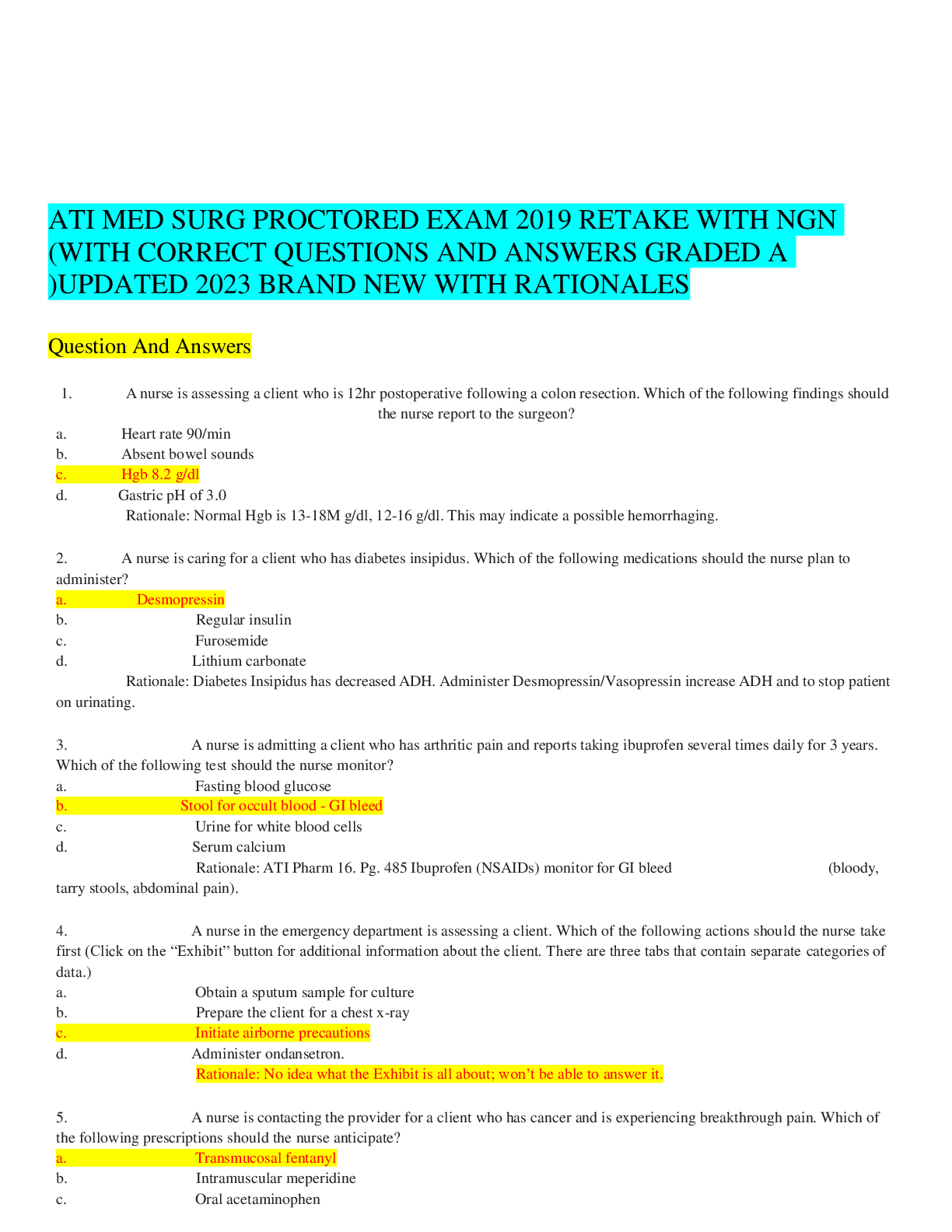
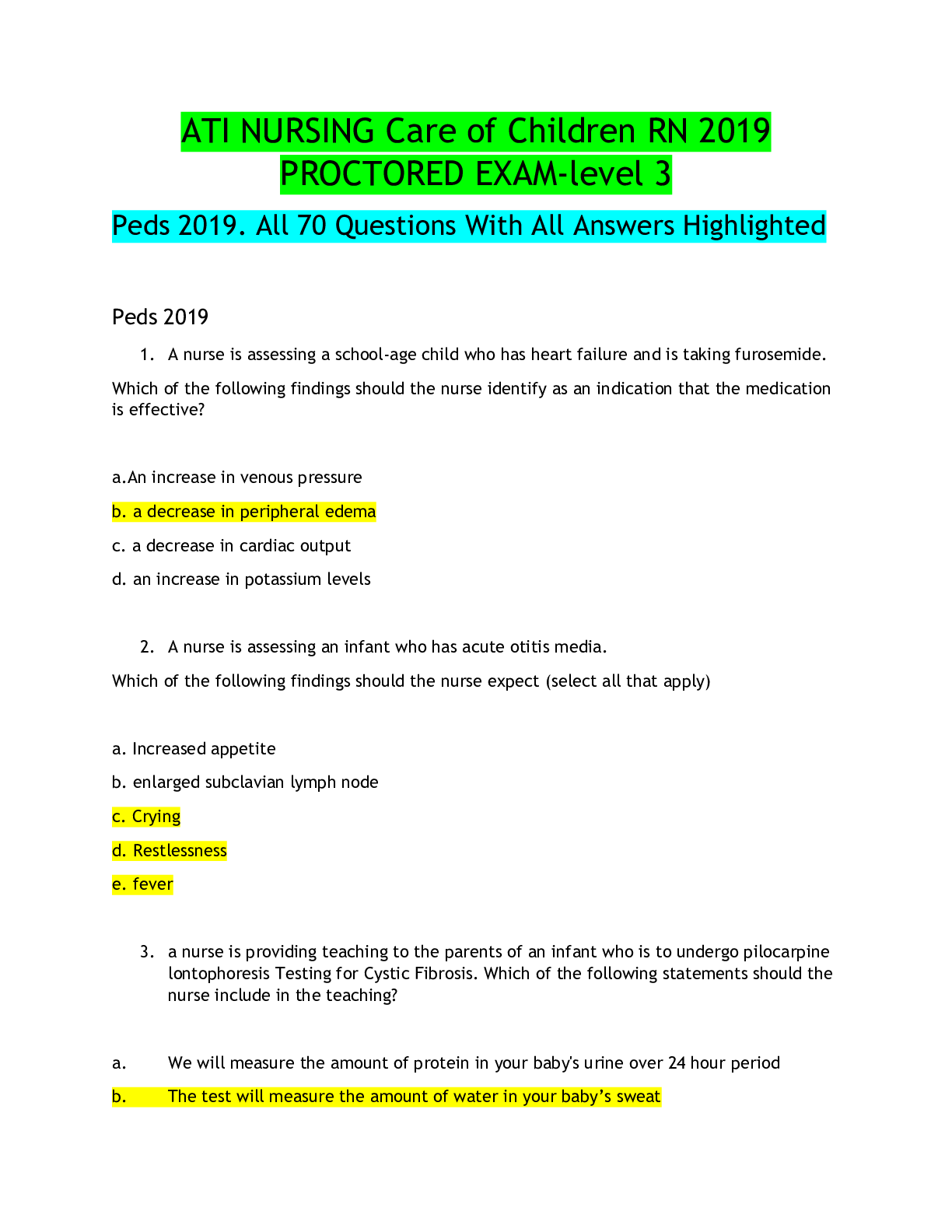
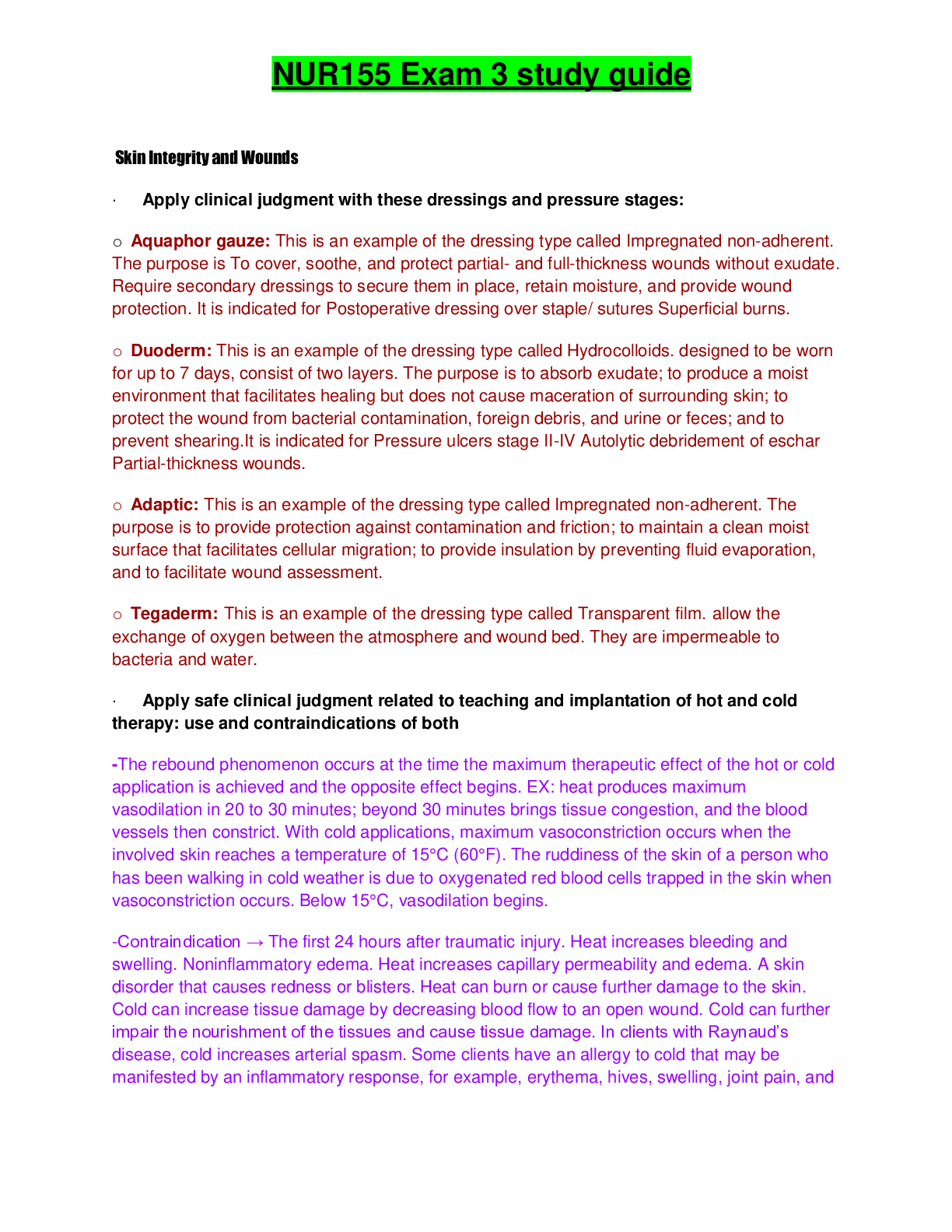

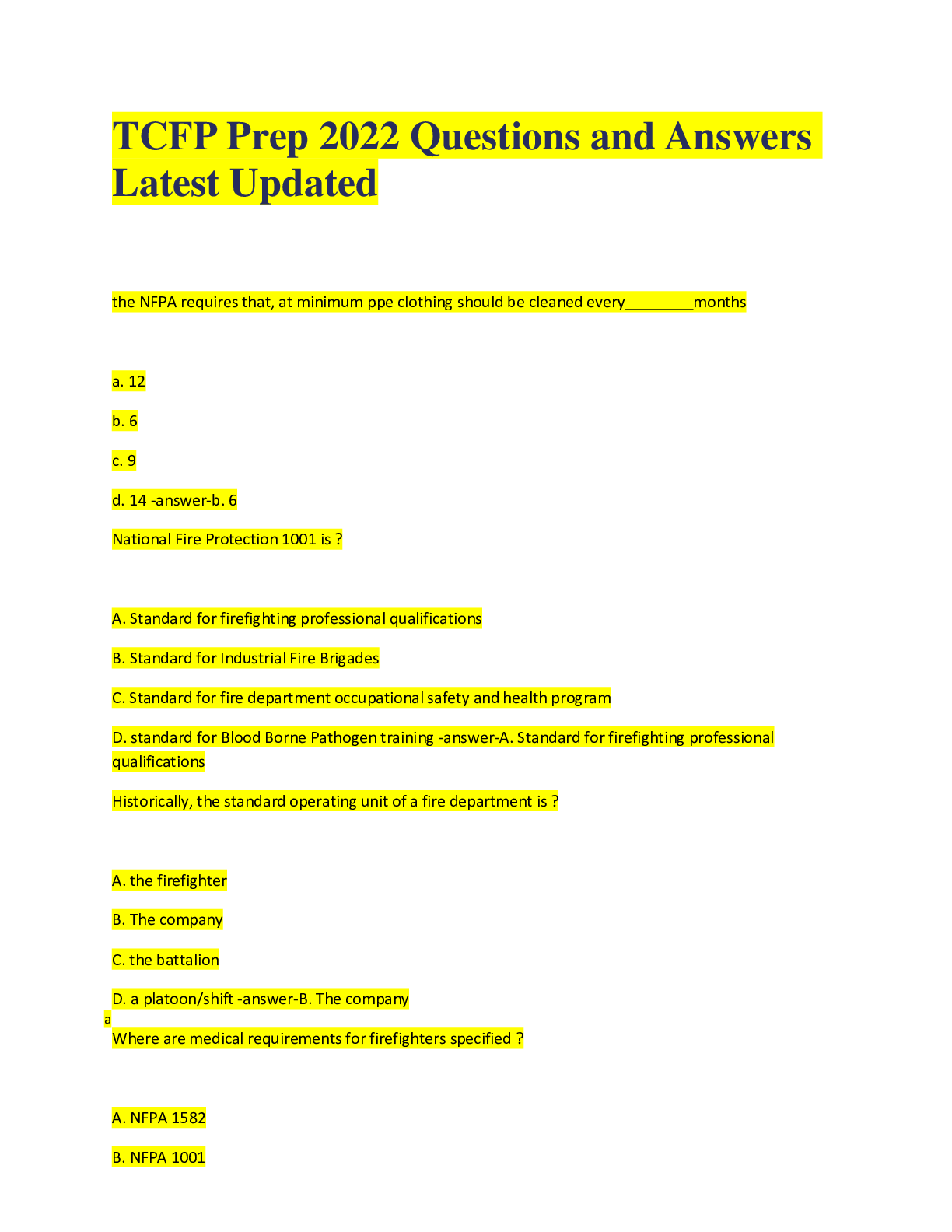
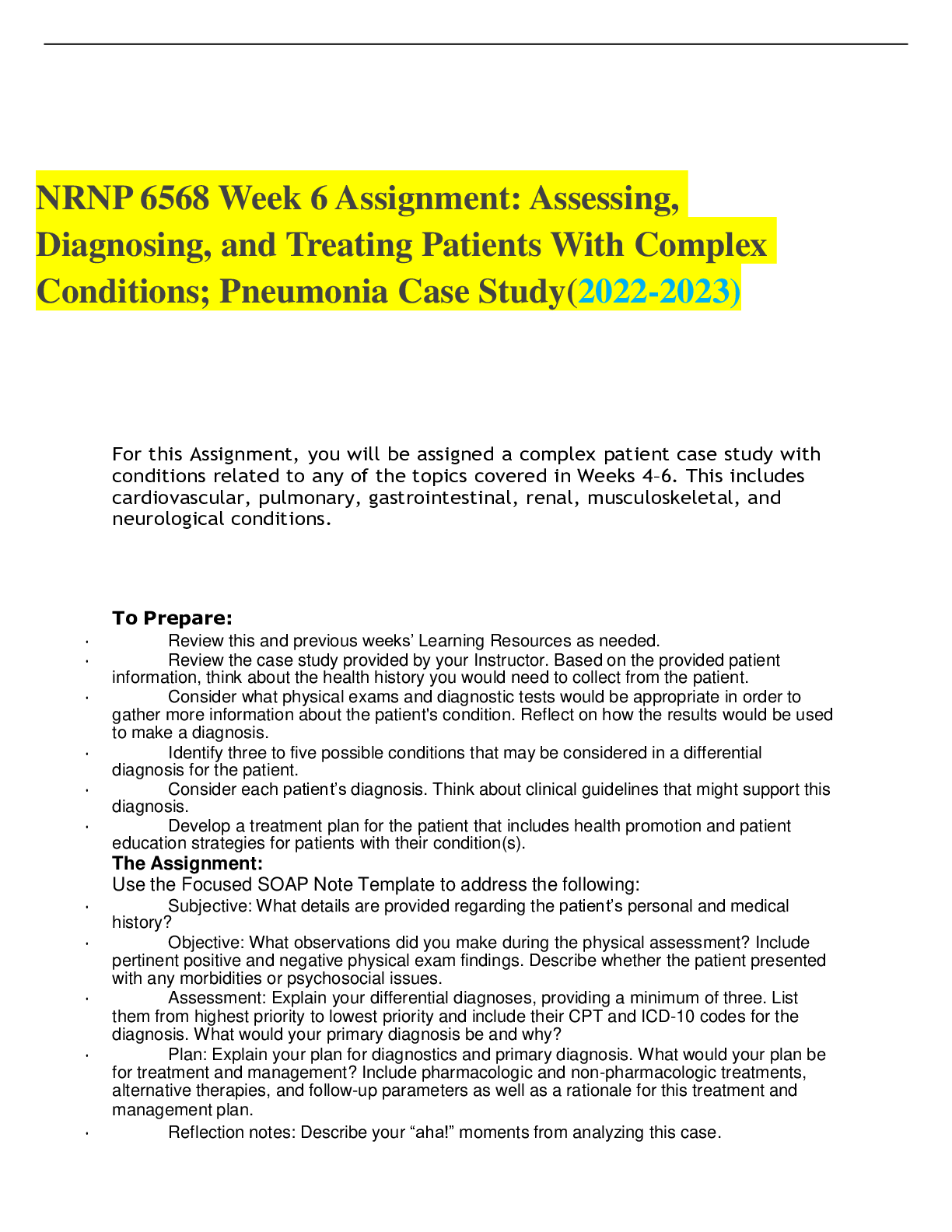
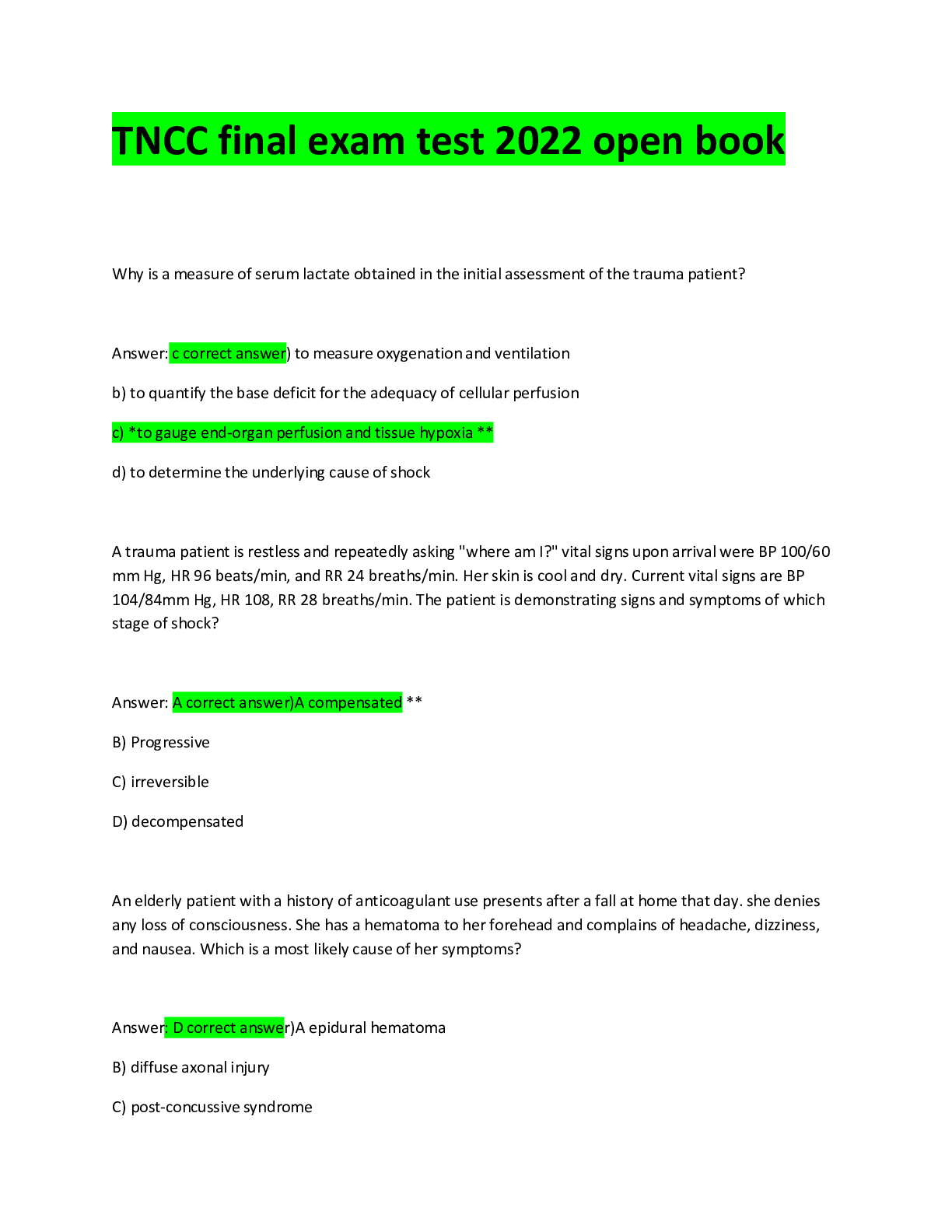
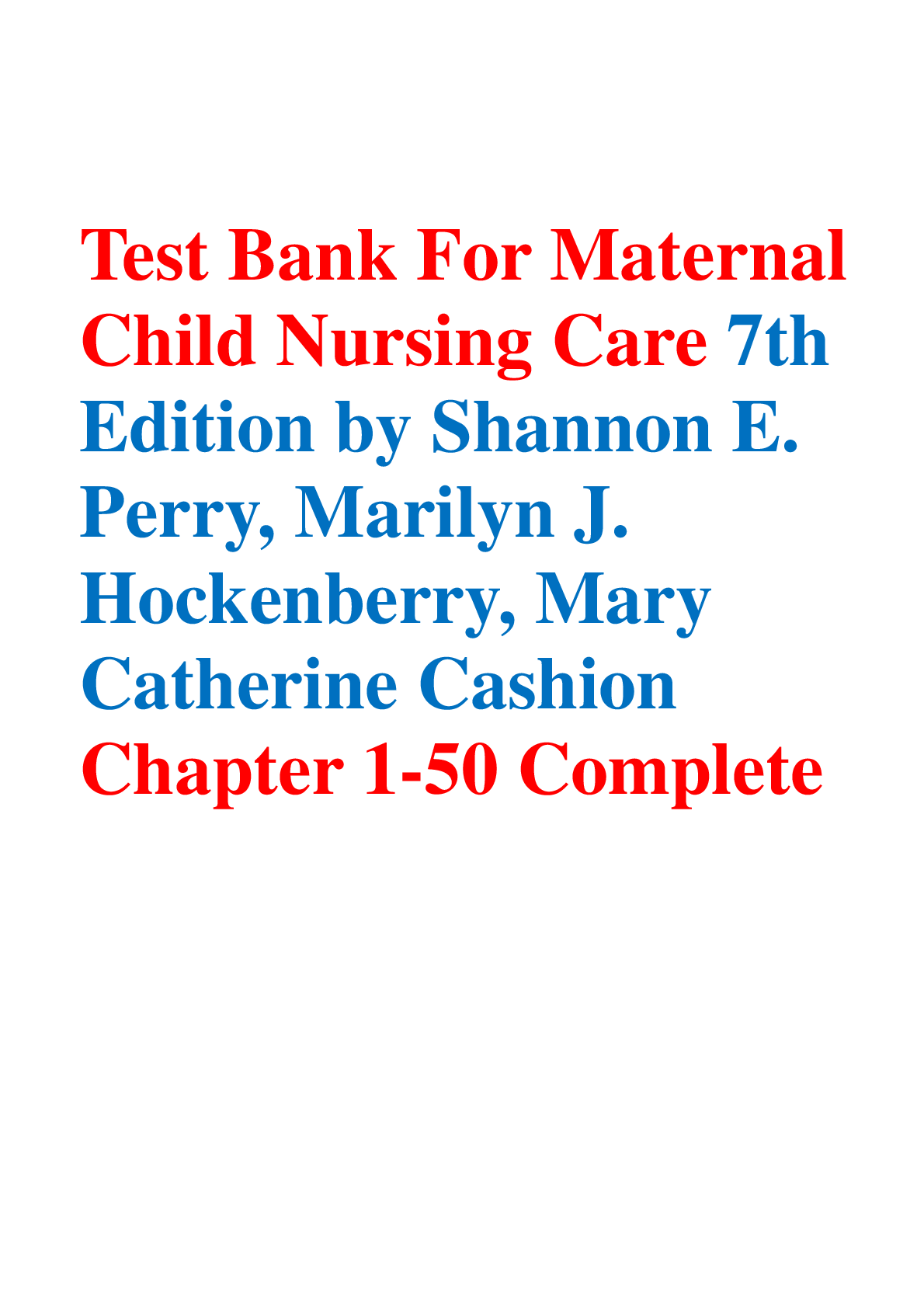

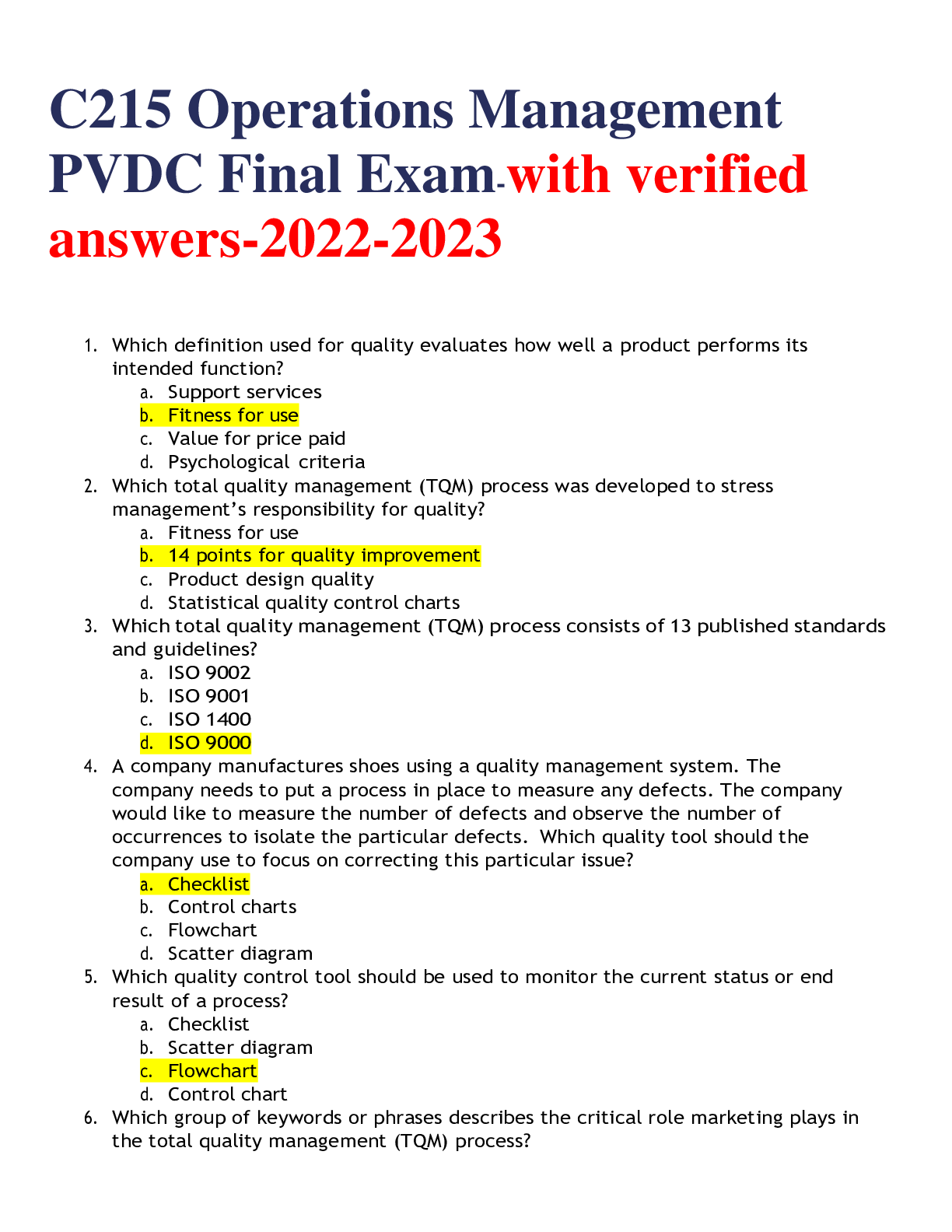
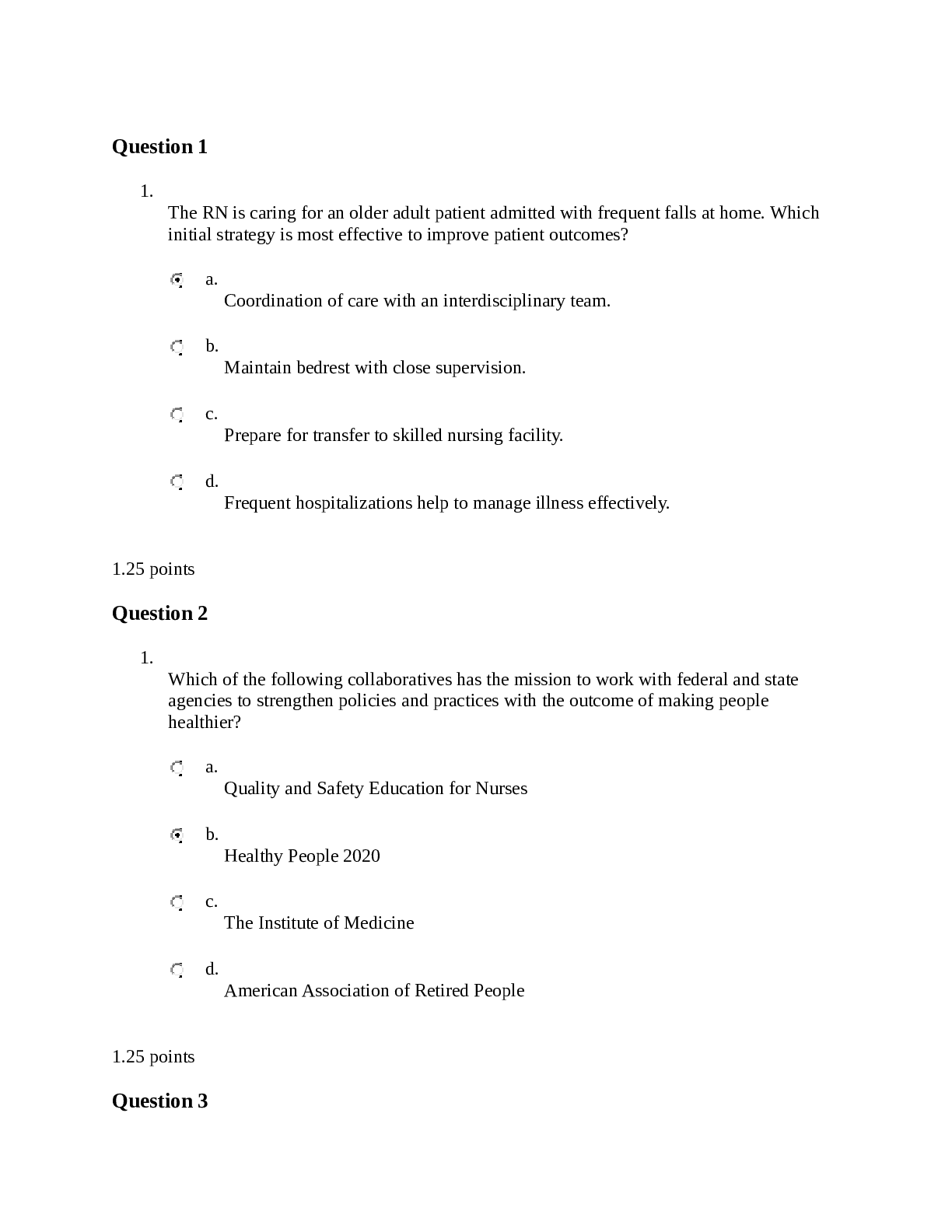
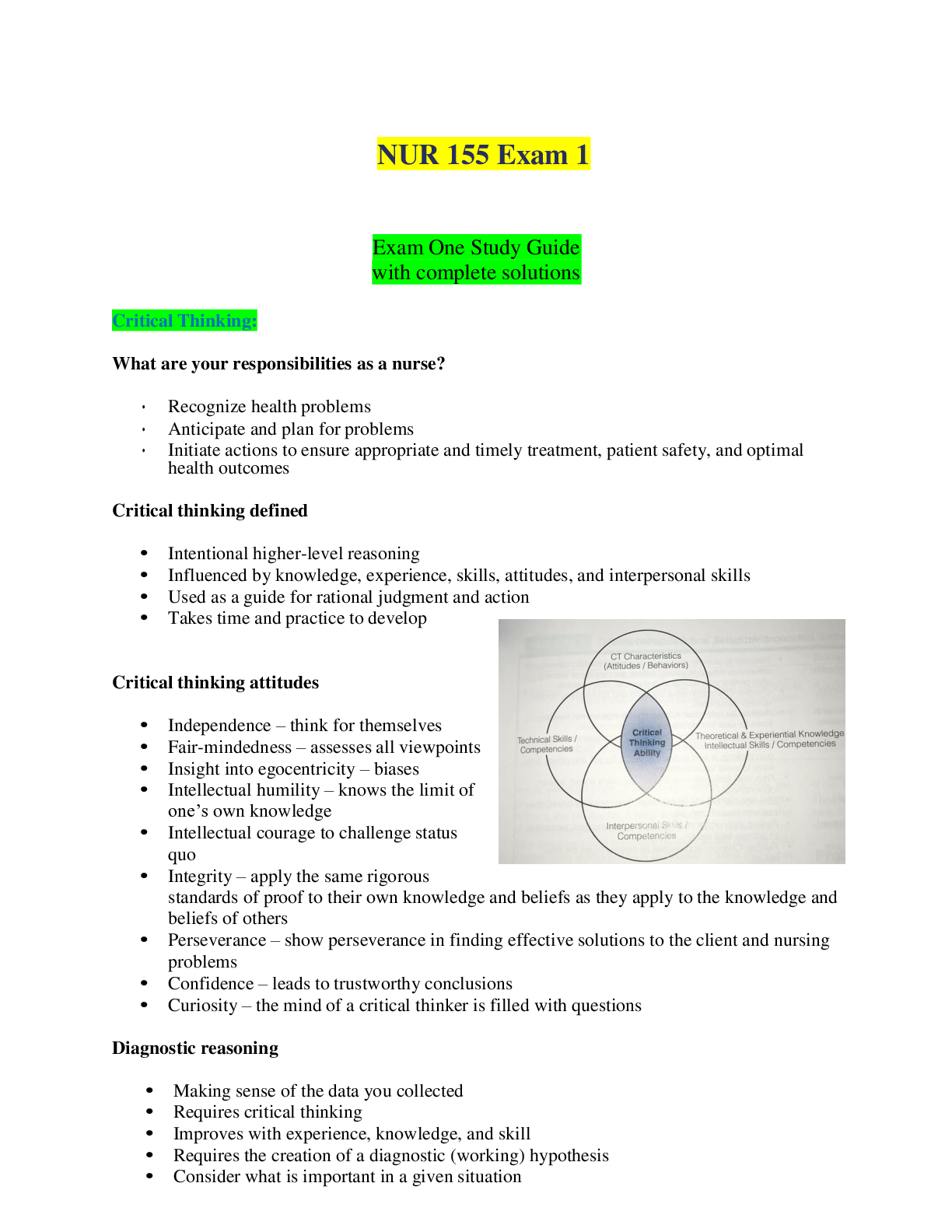


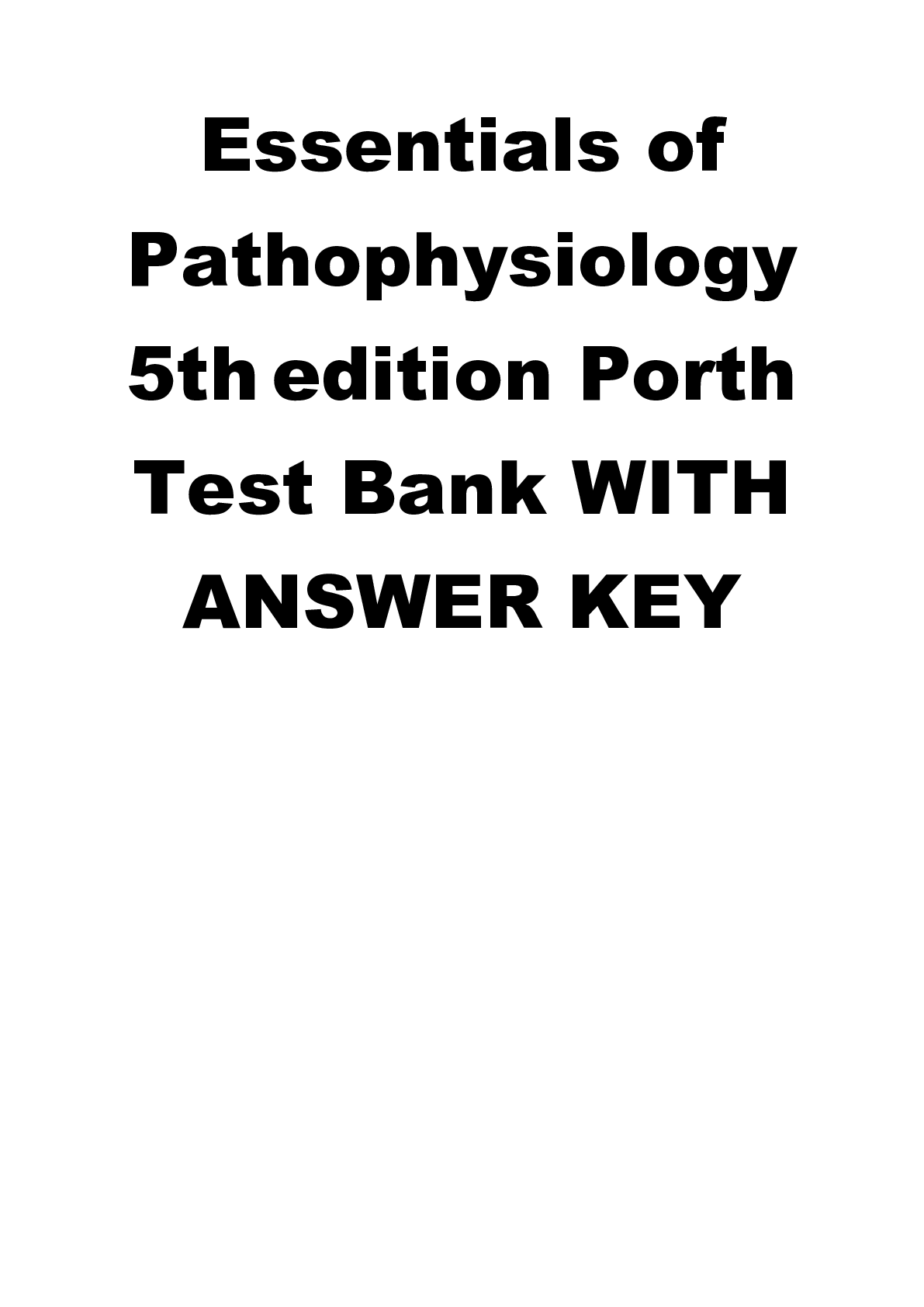
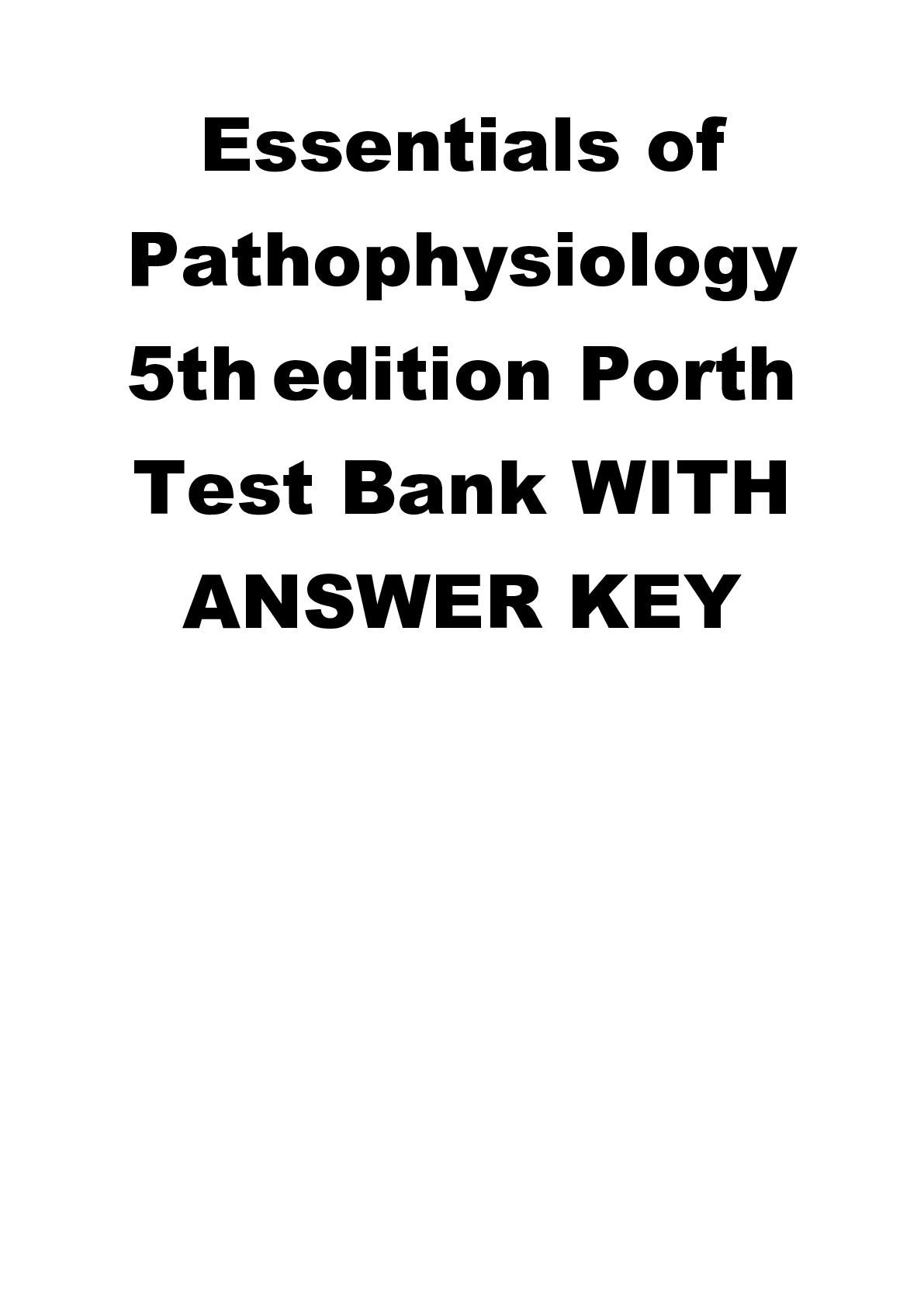
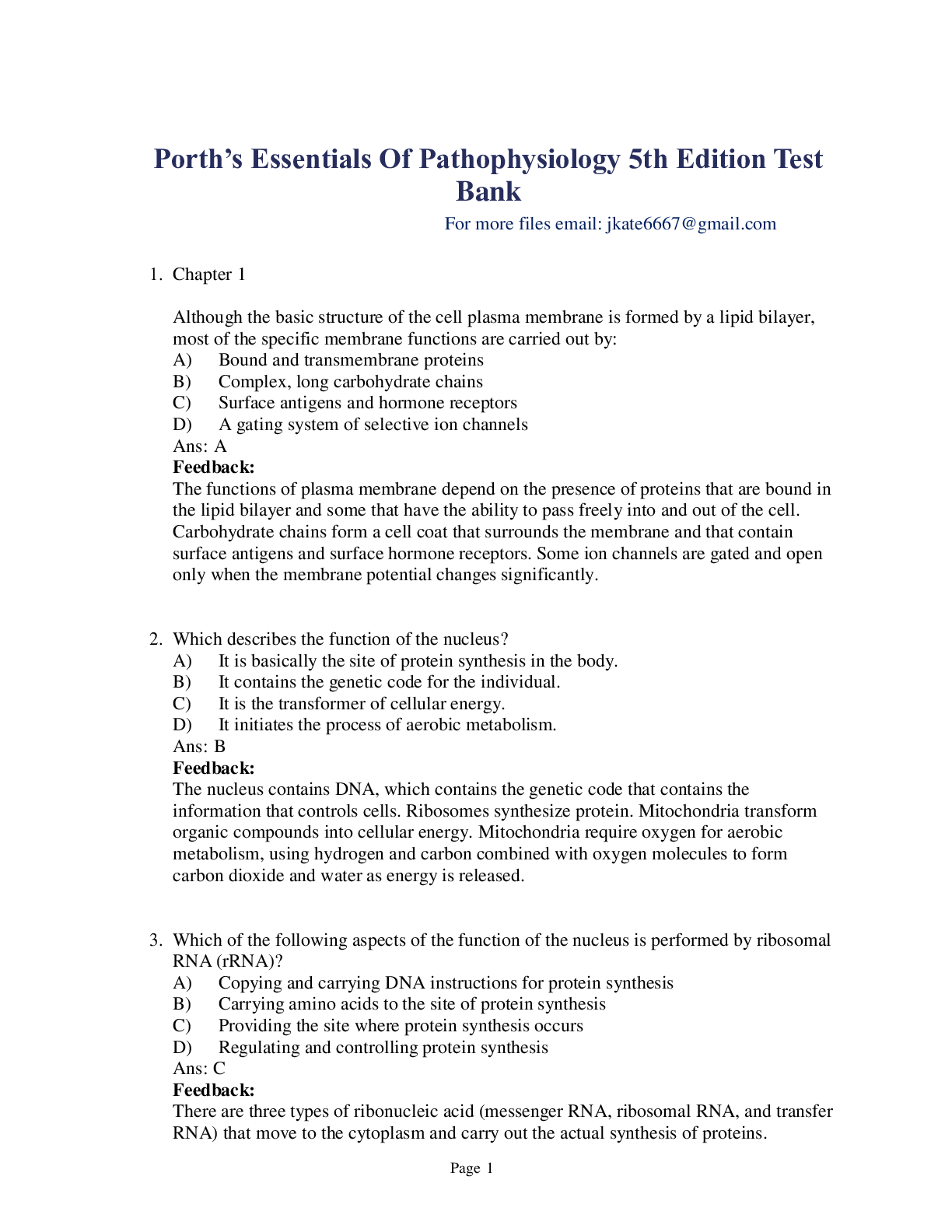
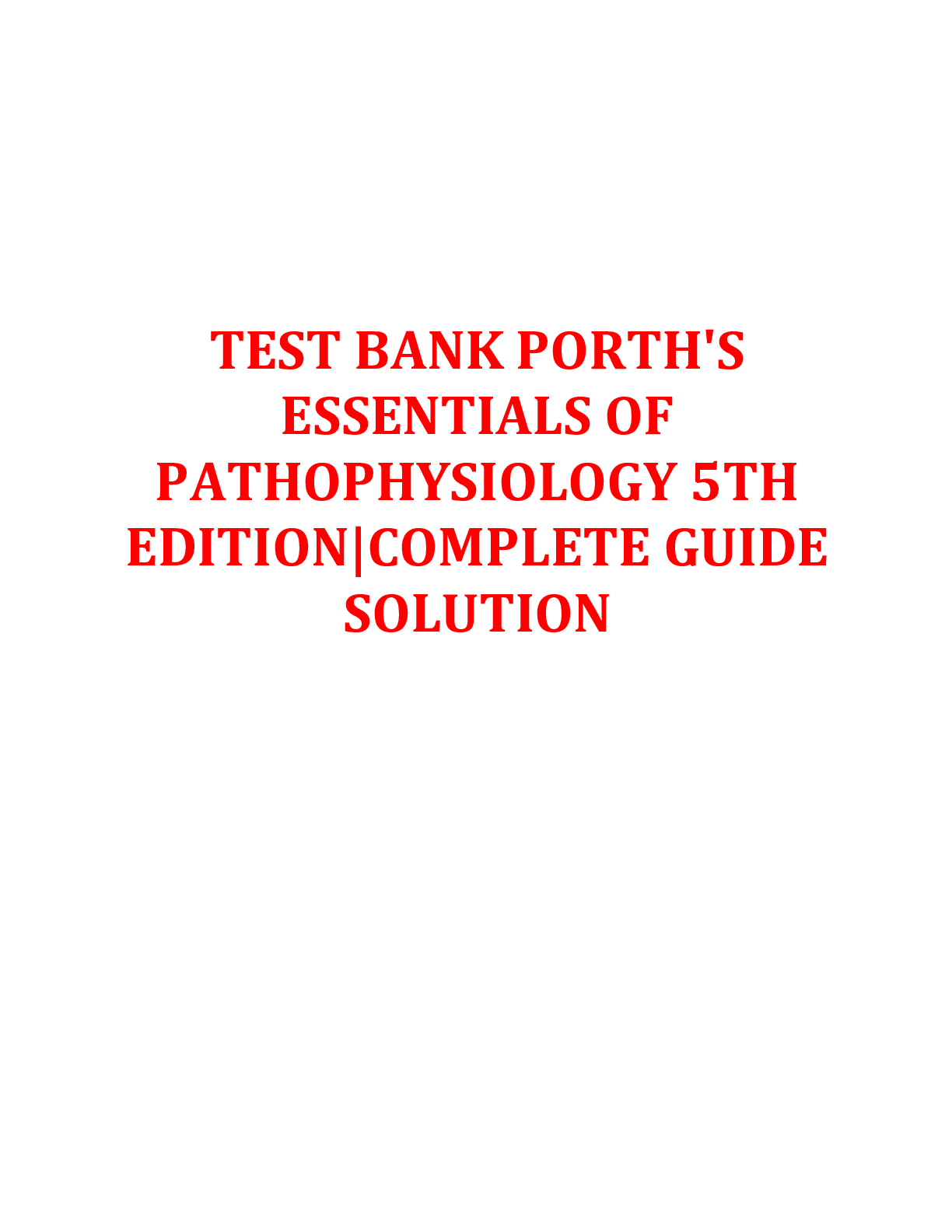
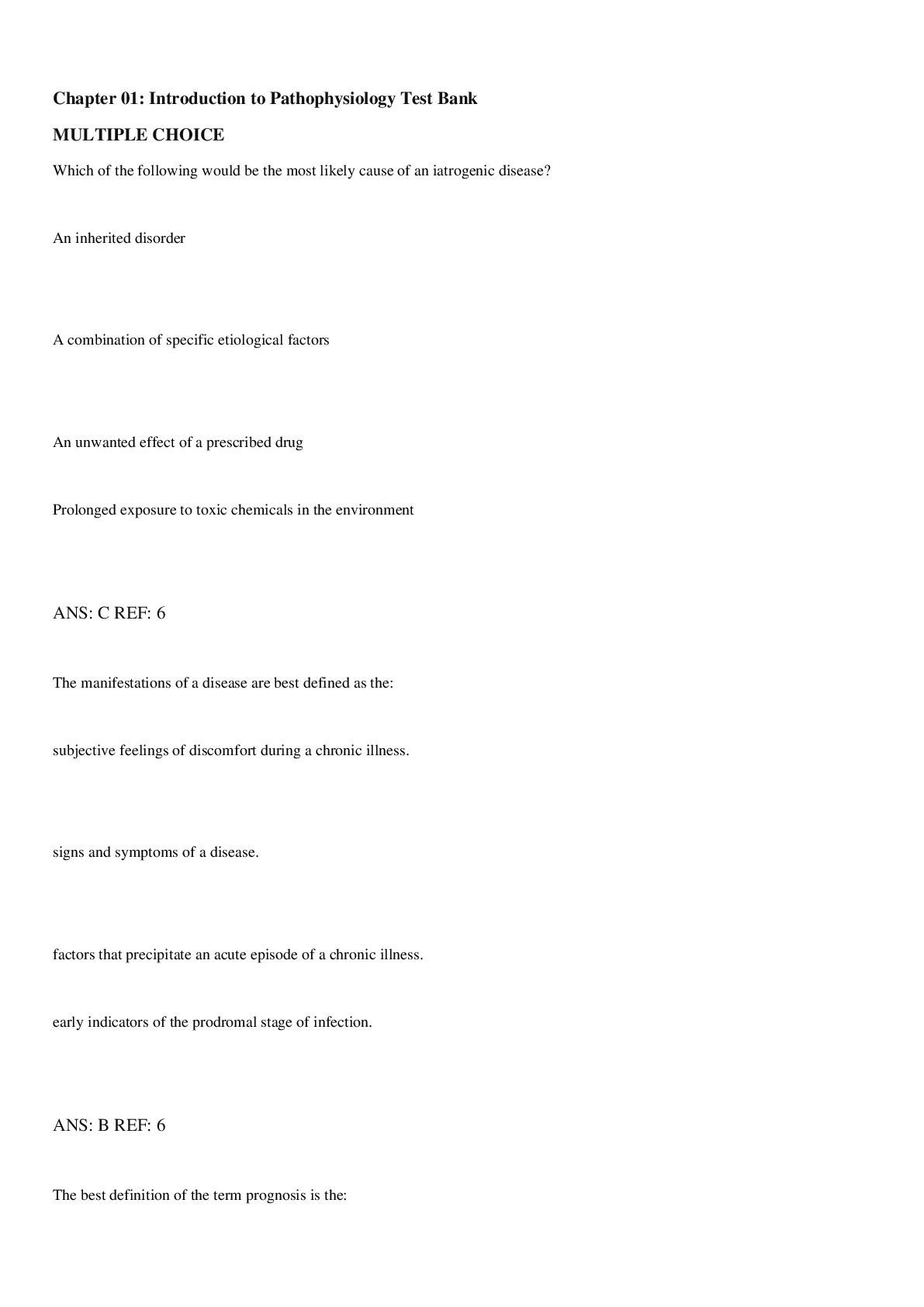
.png)


